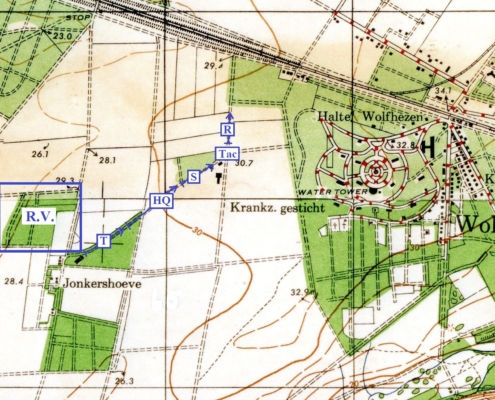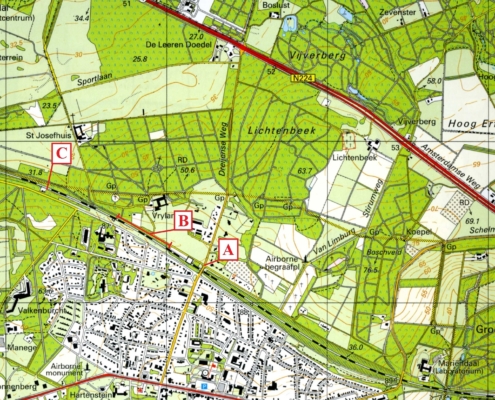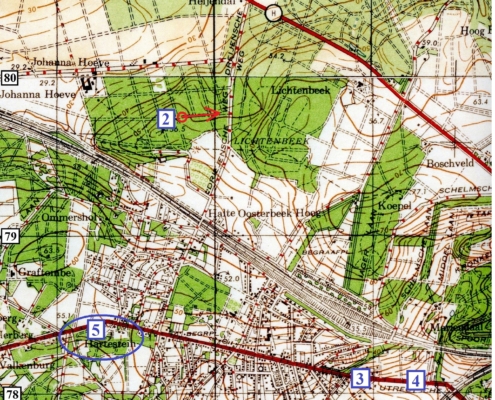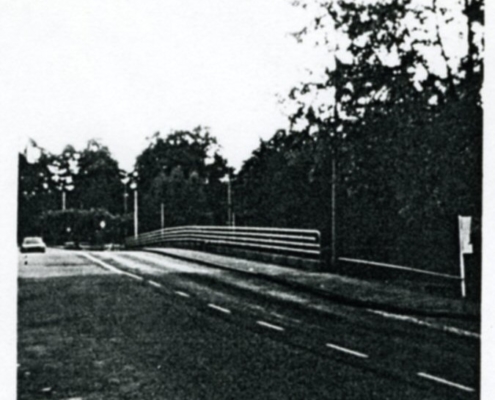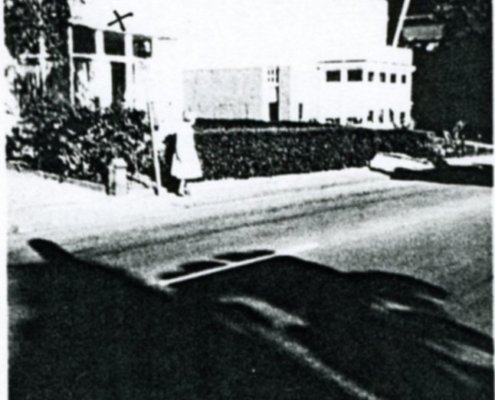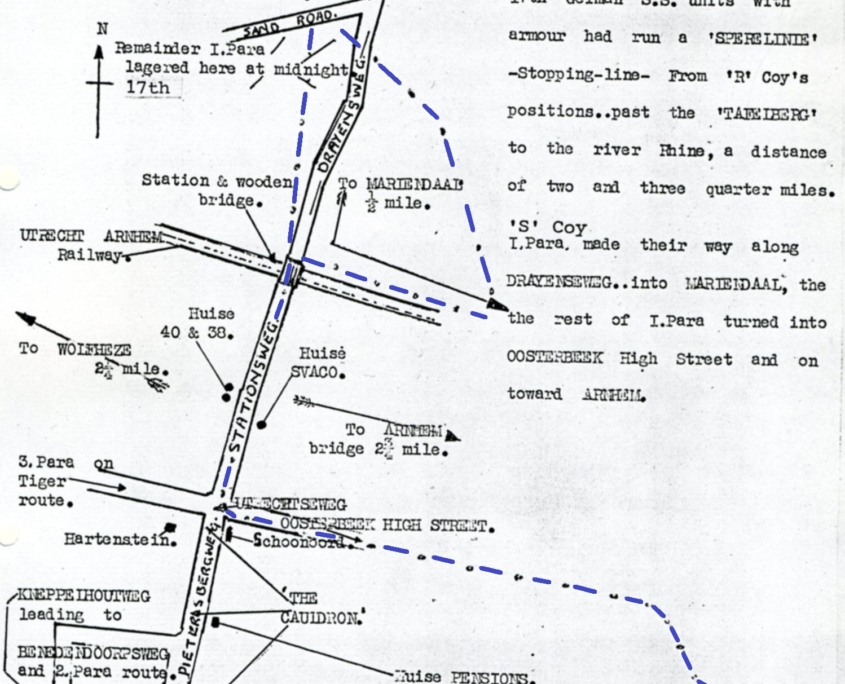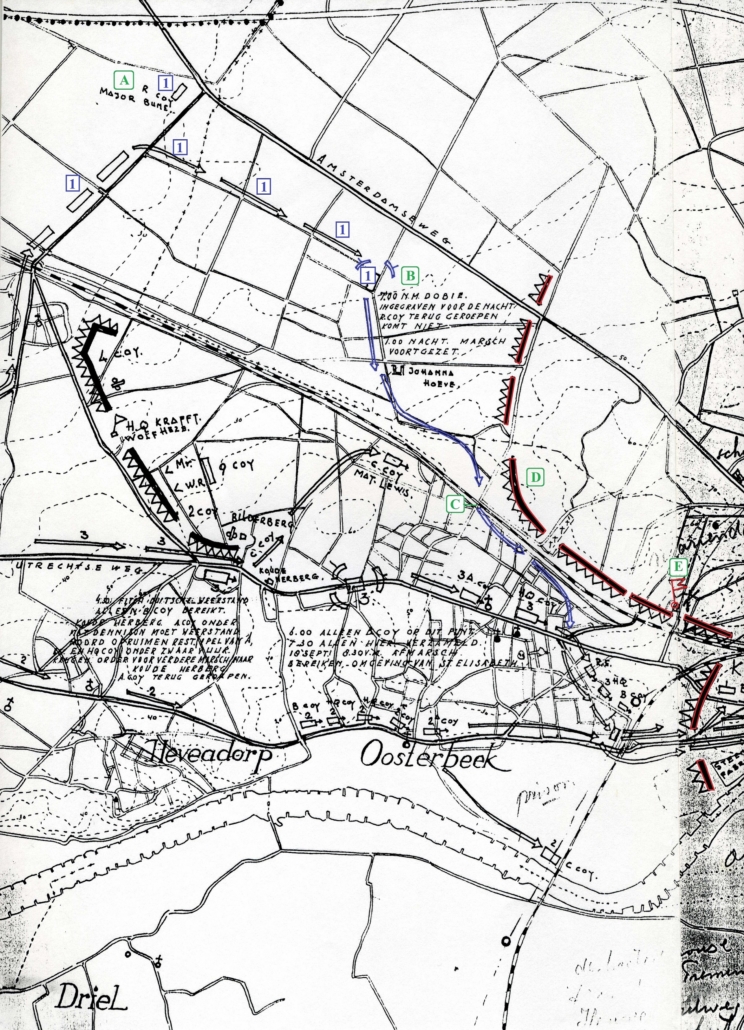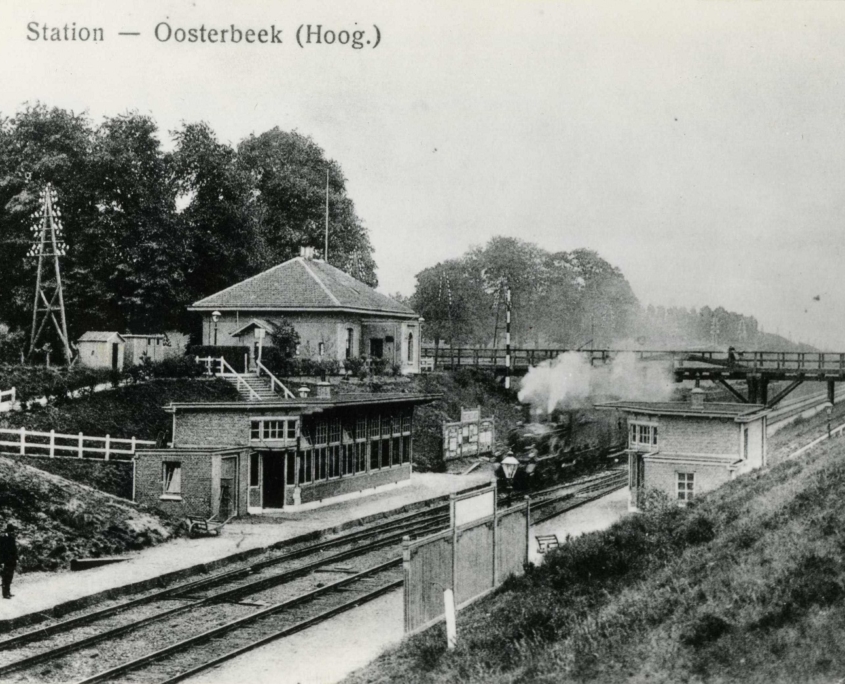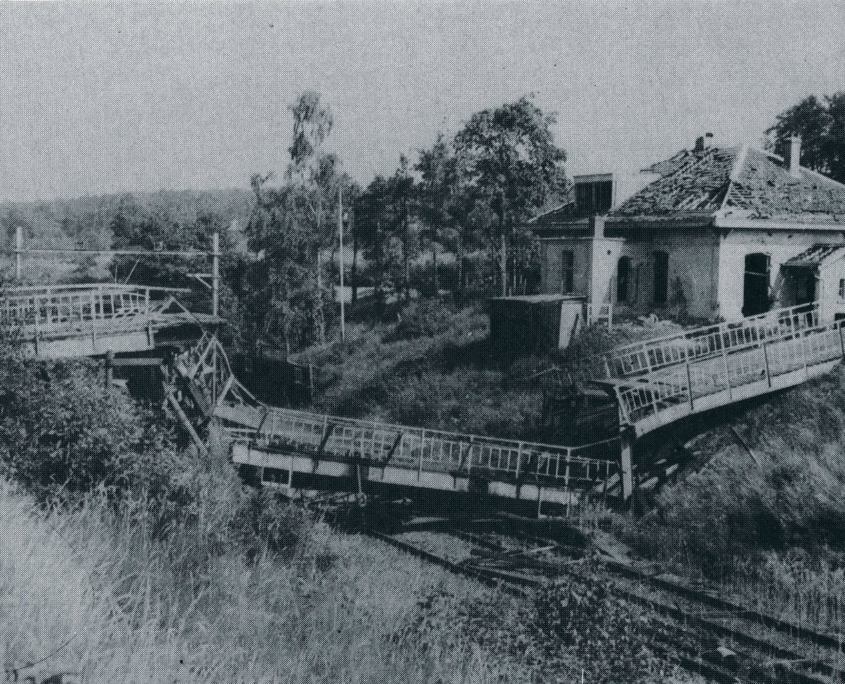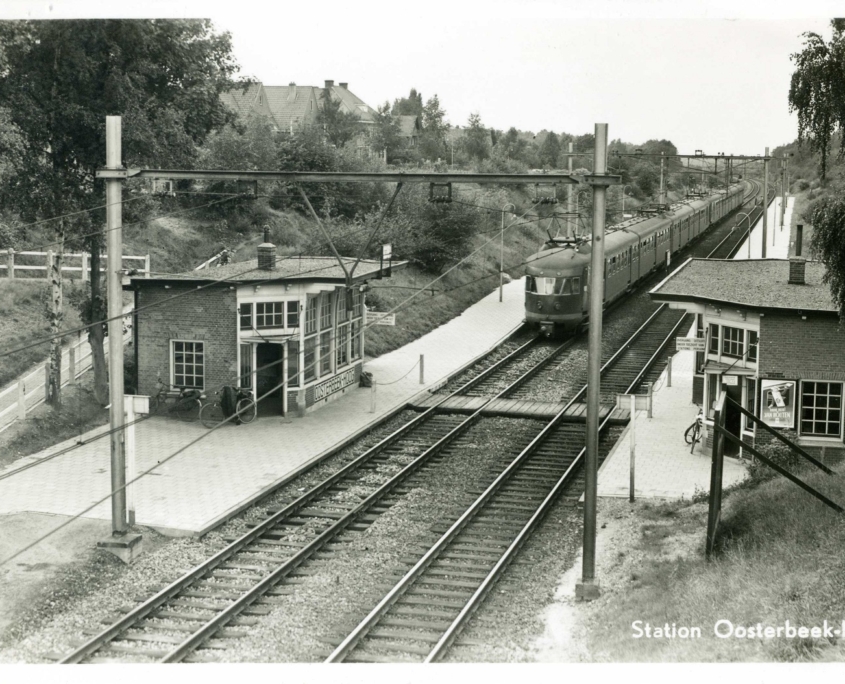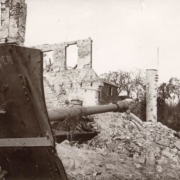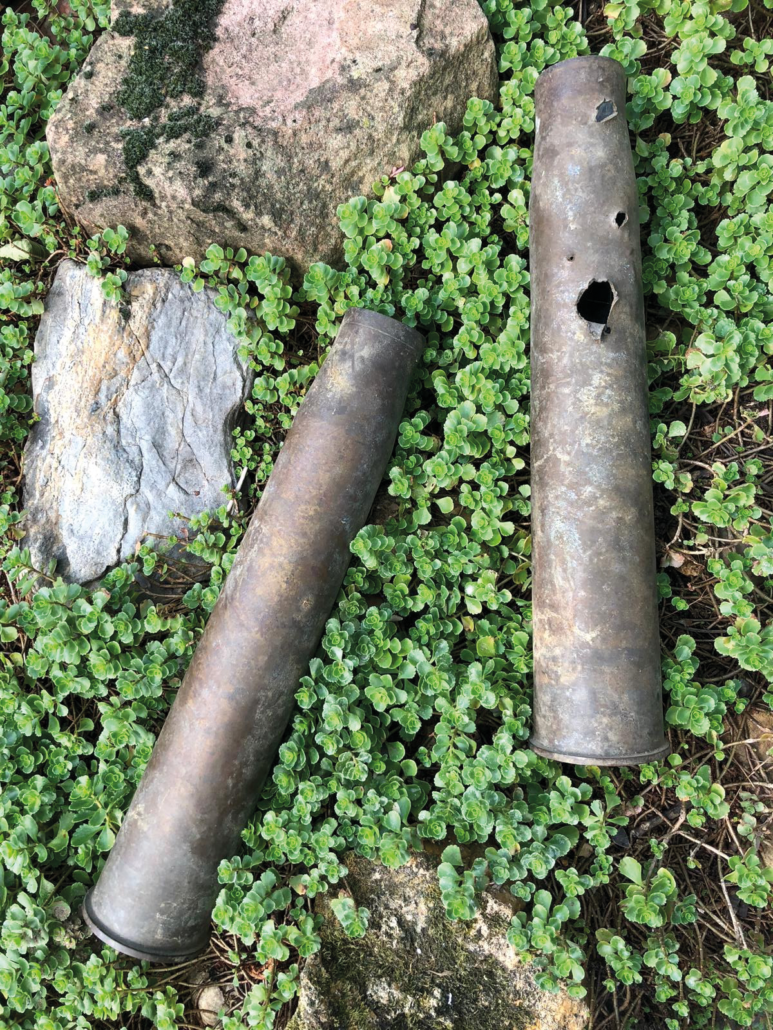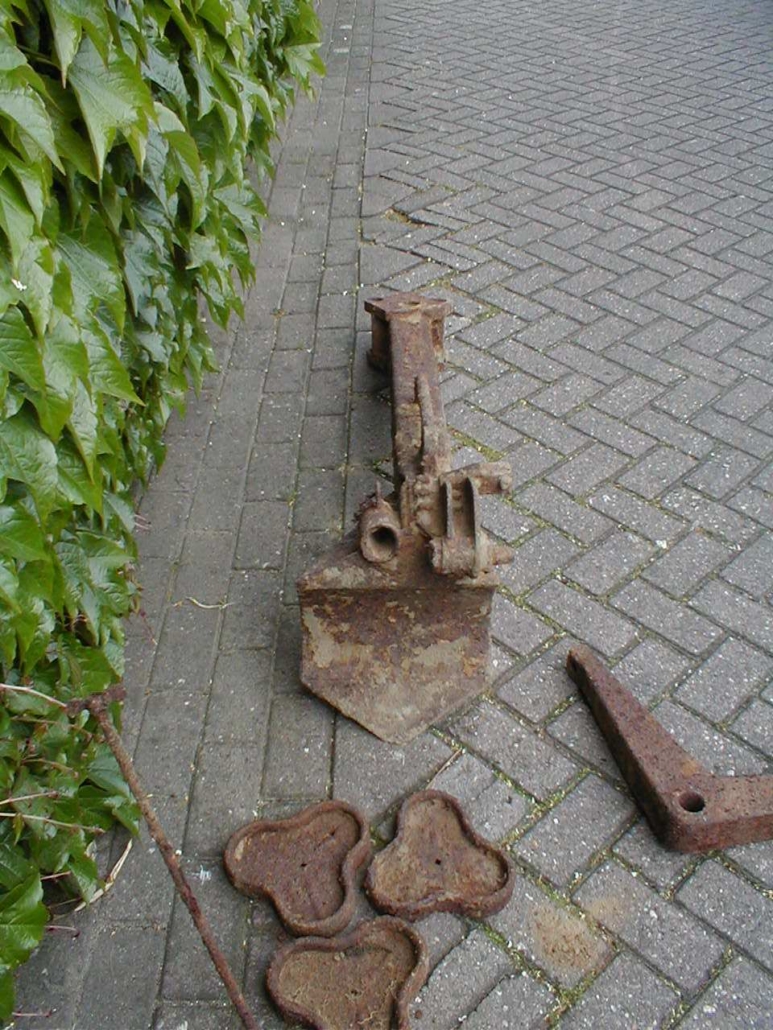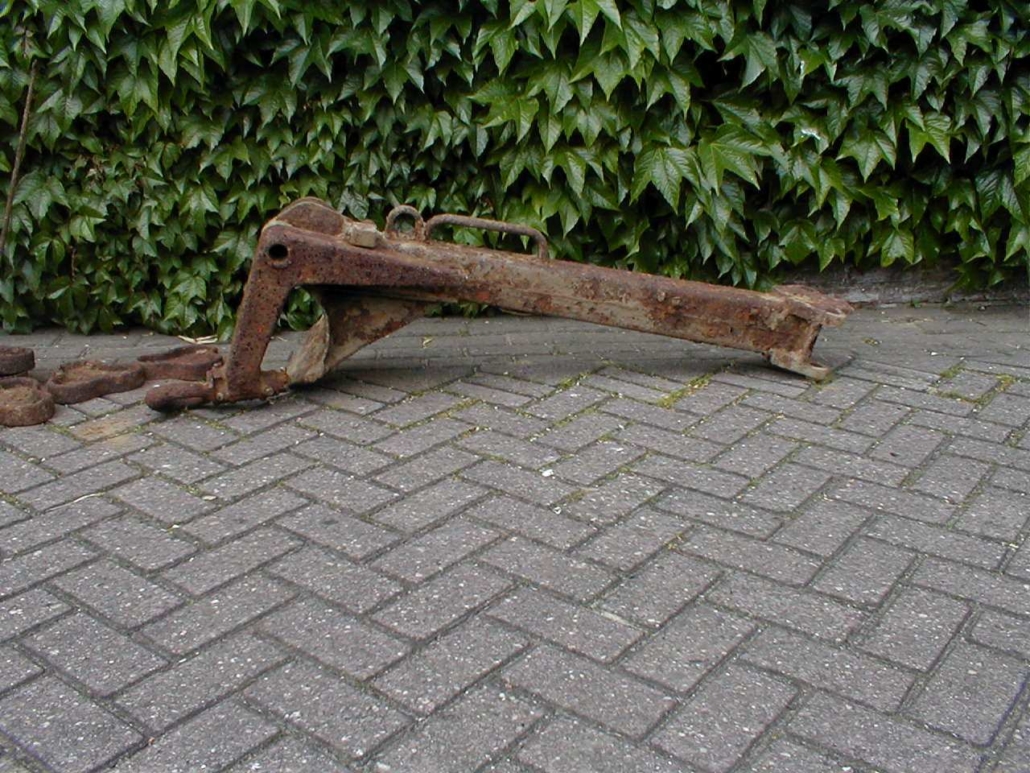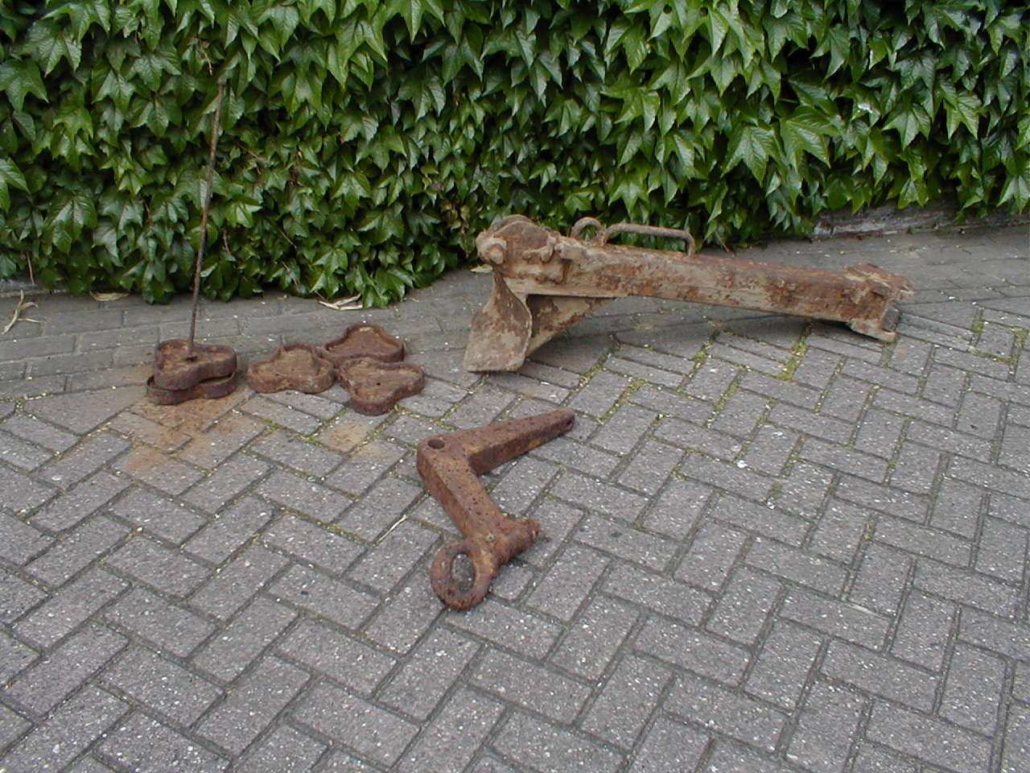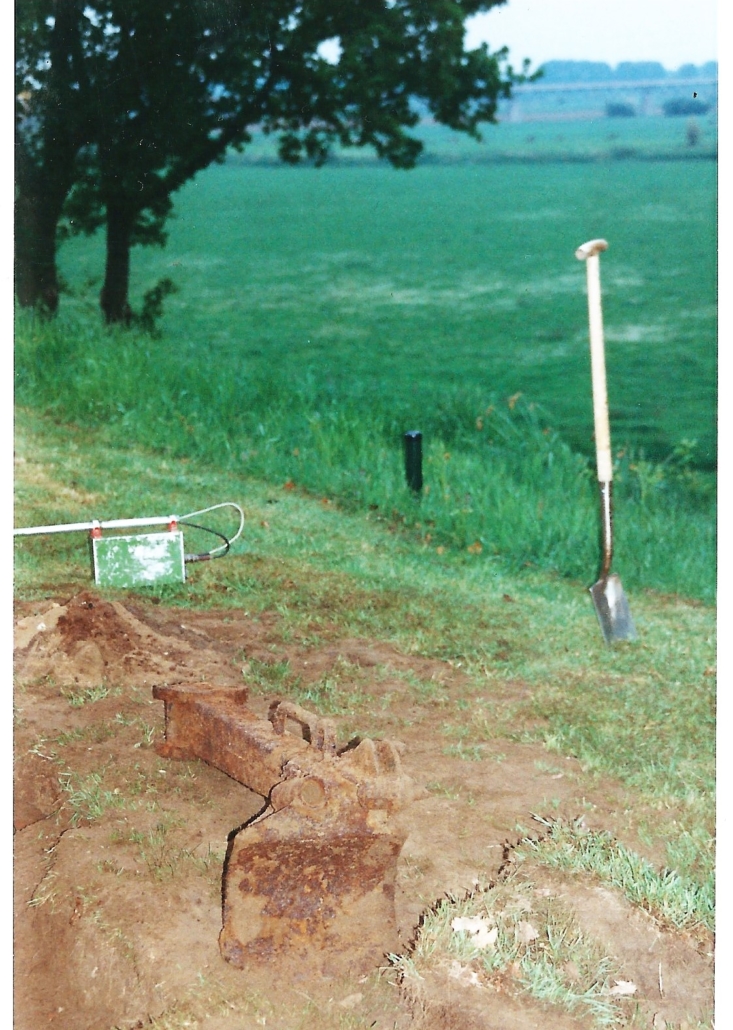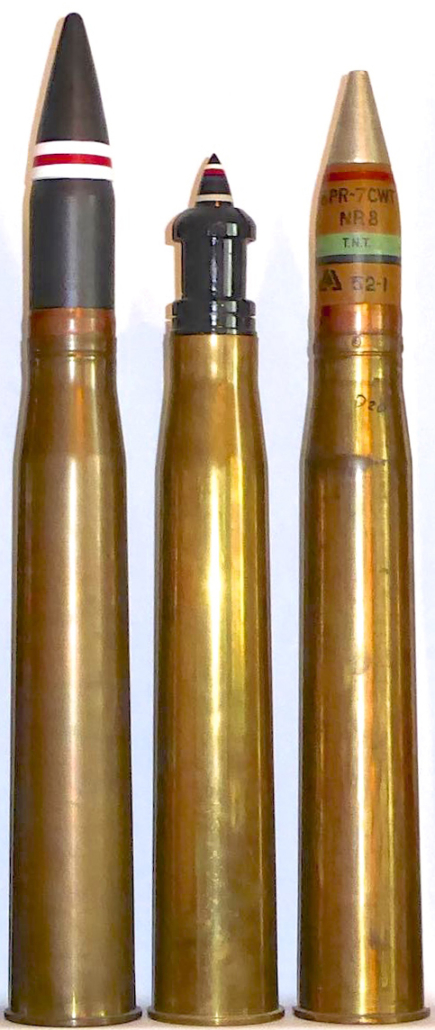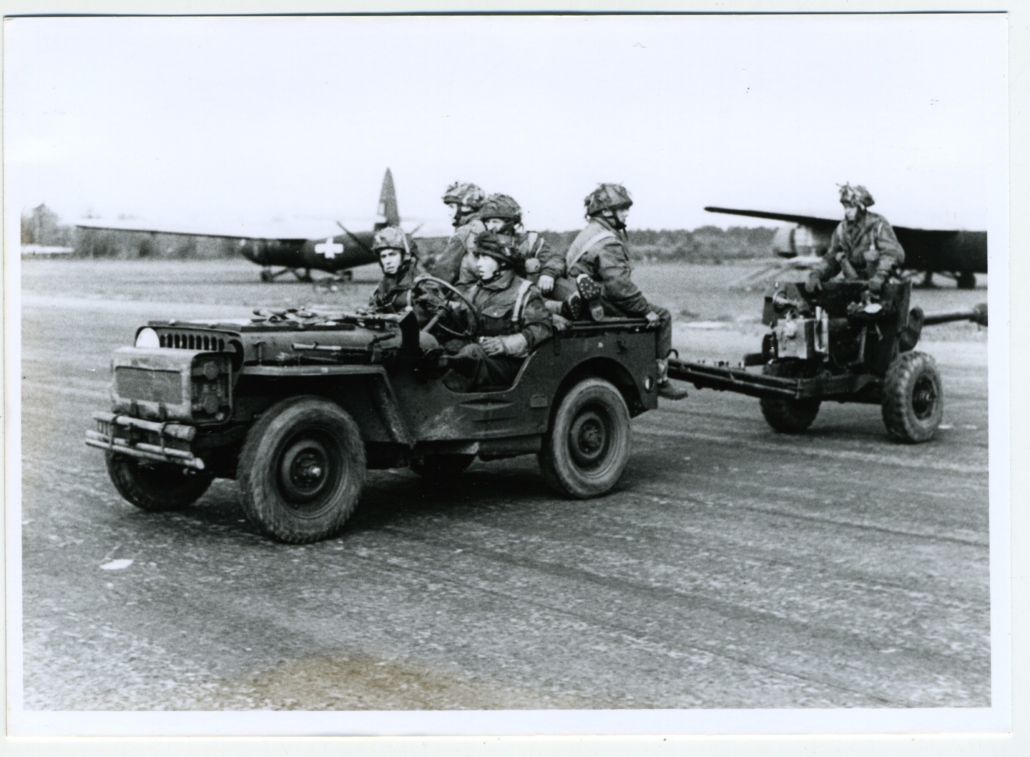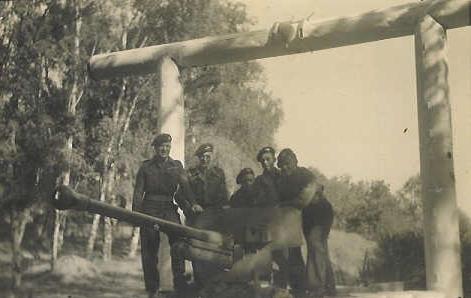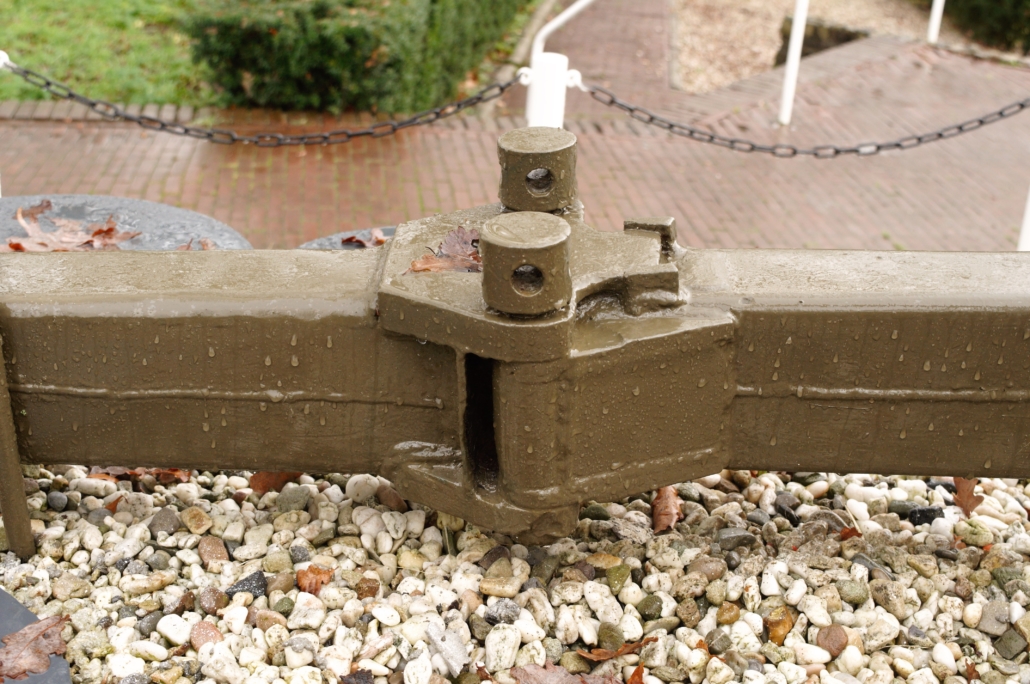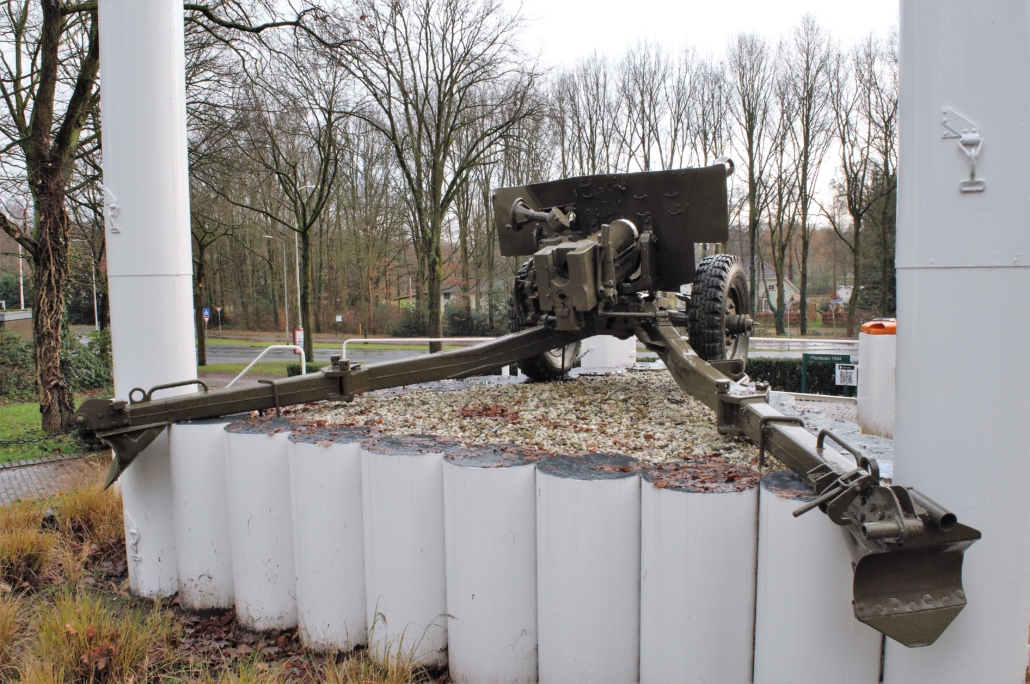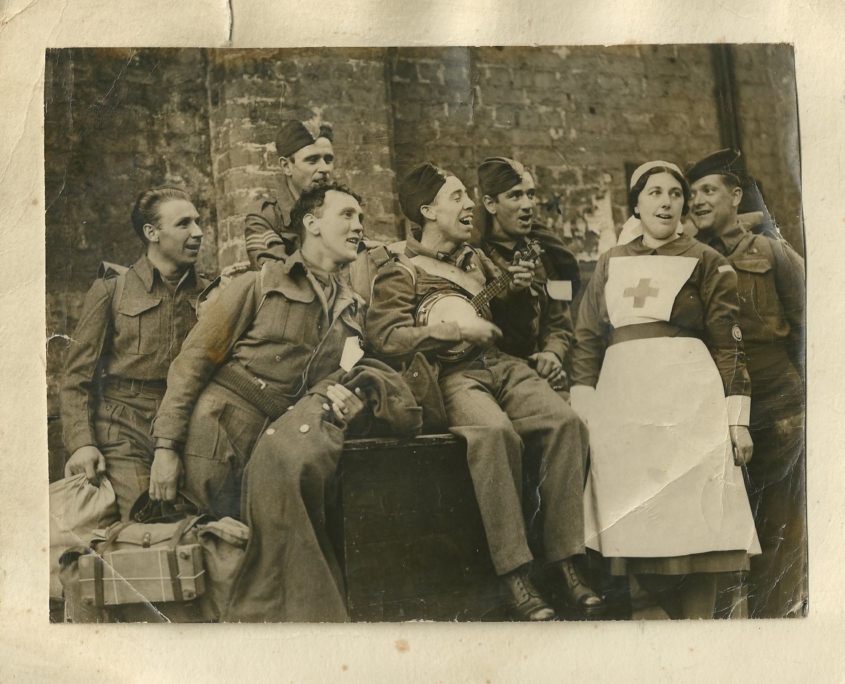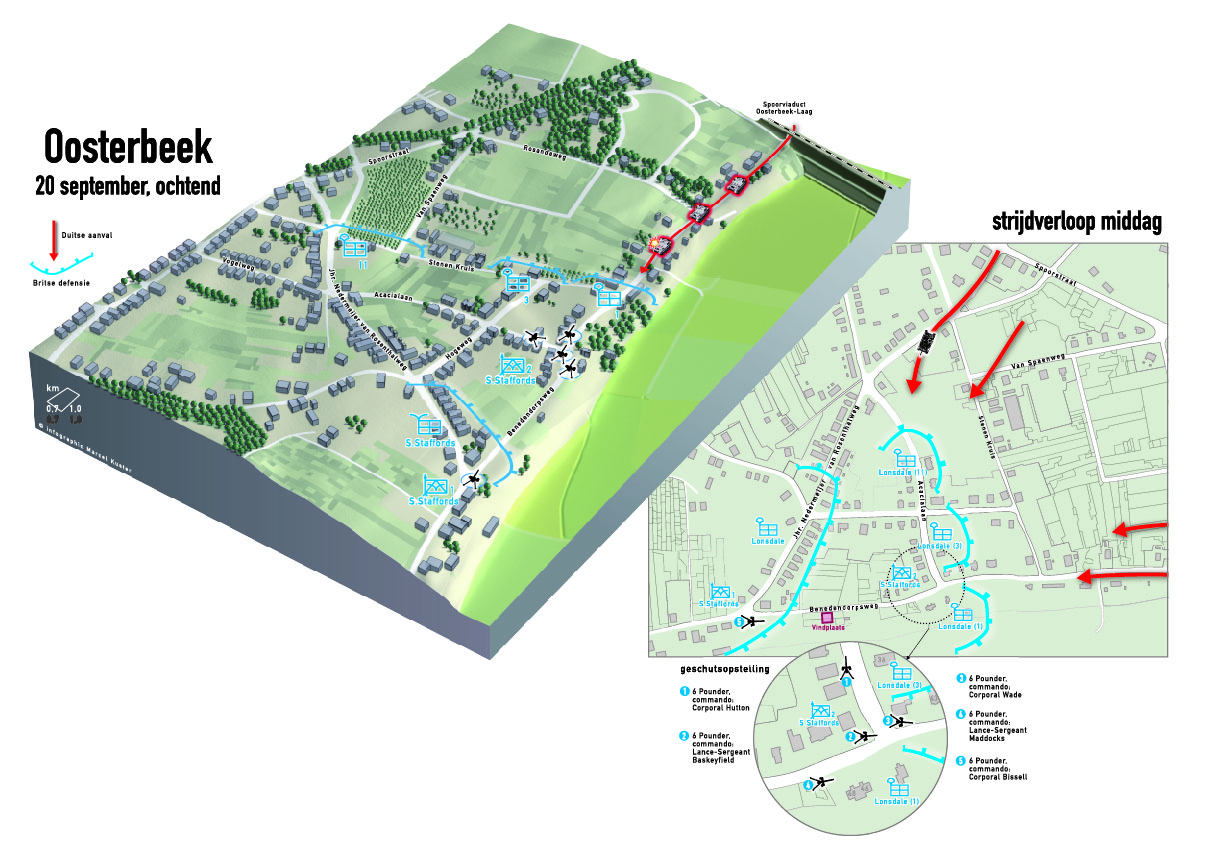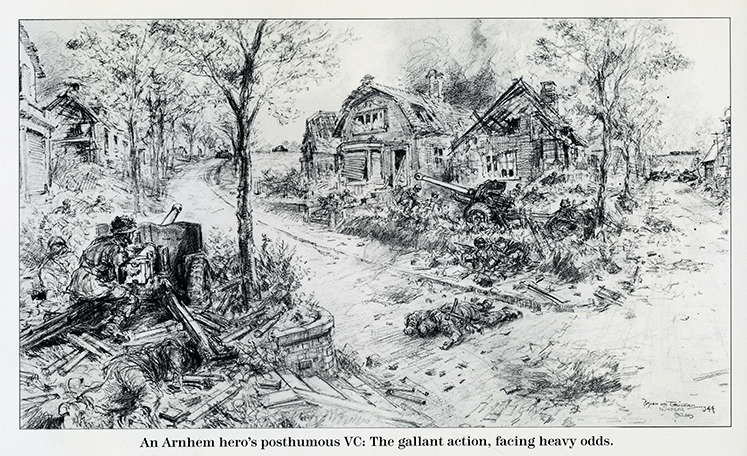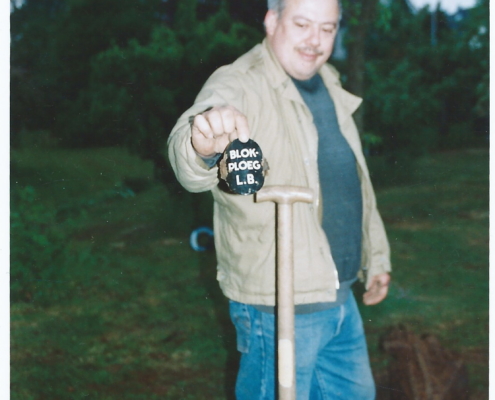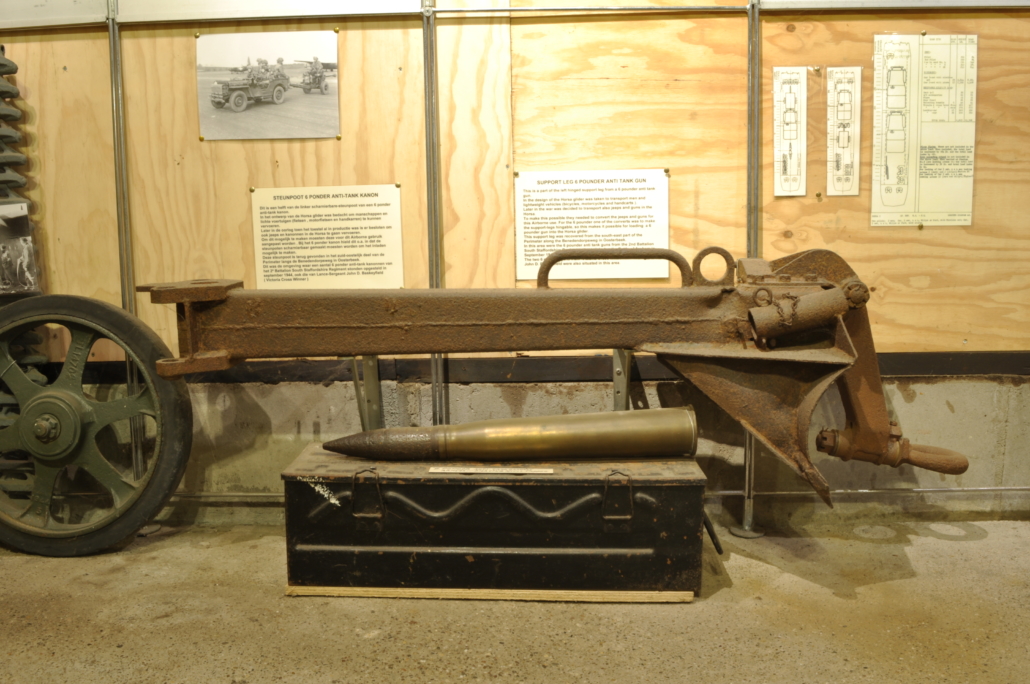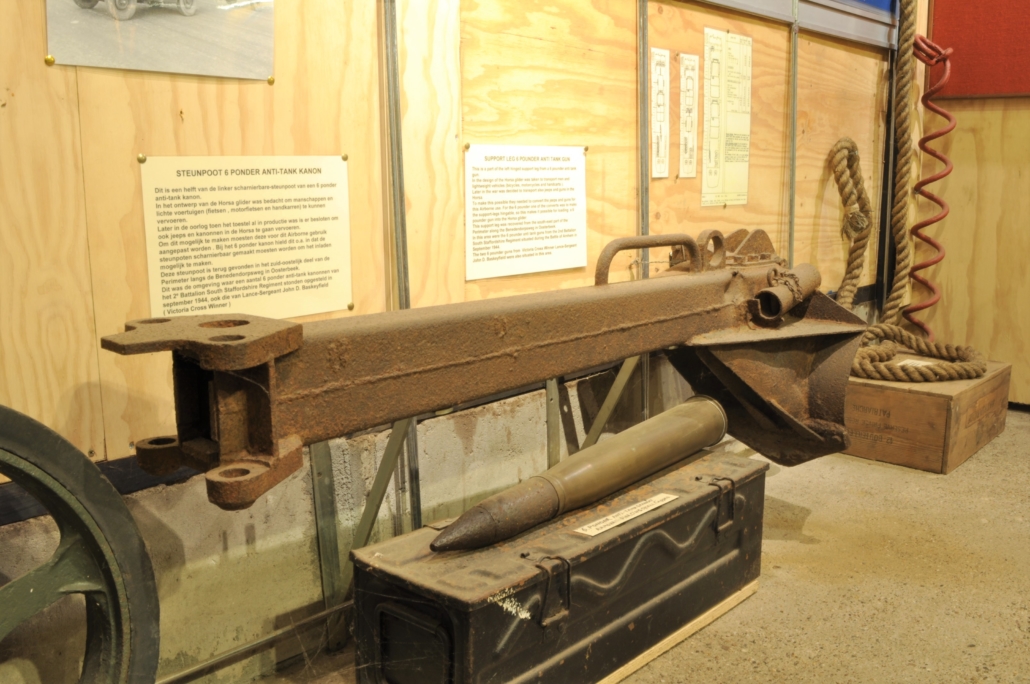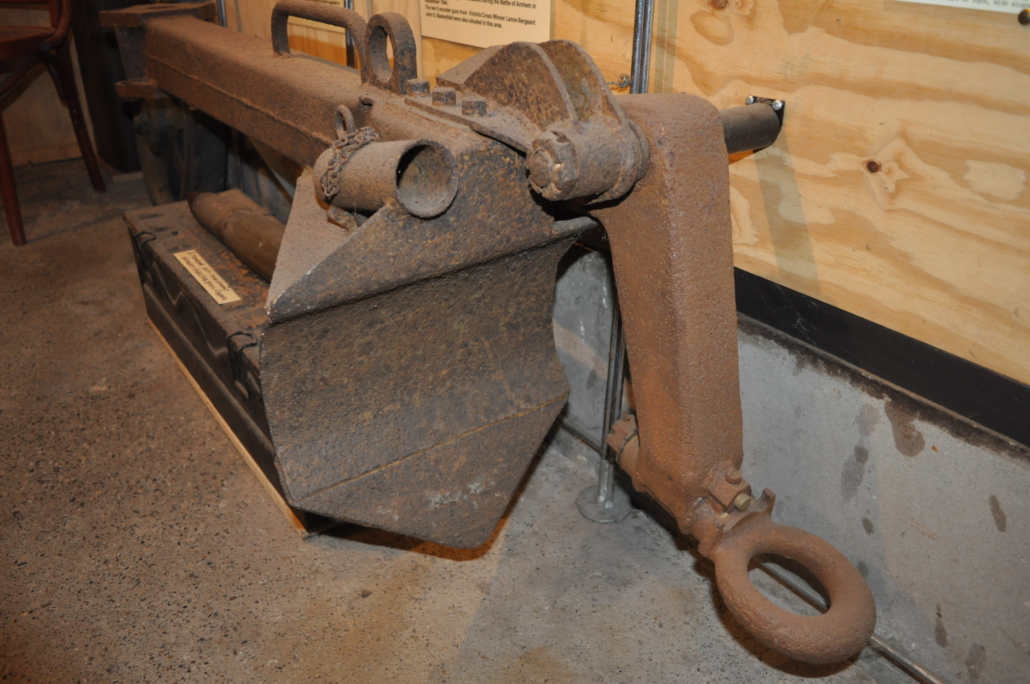Redactie Nieuwbrieven / Editors Newsletters & Airborne Magazine
De redactie van de Nieuwsbrief is vanaf het begin in de handen van drs. R.P.G.A. Voskuil. Vanaf de Nieuwsbrief No. 50 (tot en met No. 92) werd de redactie van de Nieuwsbrief gevormd door R.P.G.A. Voskuil, Ch. van Roekel en G.H. Maassen jr. In de jaren 2004 – 2008 wisselde de samenstelling van de redactie van de Nieuwsbrief nog al eens. In het volgende overzicht is de samenstelling van de redactie van de Nieuwsbrief over de jaren 1980 – december 2013 opgenomen.
As of the start, Mr. R.P.G.A. Voskuil is the editor of the Newletter. From Newsletter No. 50 (up to No. 92) R.P.G.A. Voskuil, Ch. van Roekel and G.H. Maassen jr. were editors of the Newletter. In the years 2004 to 2008 the editors changed a lot. The editors over the years 1980 to December 2013 can be summarized in the next table.
No. 1 november 1980 Voskuil
No. 50 mei 1993 Voskuil, van Roekel, Maassen jr.
No. 93 april 2004 Voskuil, Maassen jr.
No. 99 september 2005 Voskuil
No. 101 februari 2006 Voskuil, Boersma
No. 112 november 2008 Voskuil, Boersma, Bal
No. 1 Voskuil, Boersma, Jansen, conservator AM (vacature/vacancy)
No. 2-4 Voskuil, Boersma, Jansen, Helsen
No. 5 Voskuil, Boersma, Helsen
No. 6 Voskuil, Boersma, conservator AM (vacature/vacancy)
No. 7 Voskuil, Boersma
No. 8 Boersma
No. 9-10 Boersma, Oorthuys (+ vacature/vacancy)
No.11 Oorthuys, van Wiggen
No.12-16 Heusschen, Oorthuys, van Wiggen
No 17 Heusschen, van Midden, van Putten
Nieuwbrieven 1980 – 2013
In de Nieuwsbrieven zijn vele artikelen opgenomen. In deze paragraaf is een overzicht opgenomen van de titels van de opgenomen artikelen. Bij iedere Nieuwsbrief is tussen (..) aangegeven, uit hoeveel pagina’s de betreffende Nieuwsbrief bestaat. Om de inhoud te verduidelijken zijn toevoegingen door de auteur gedaan, waarbij tussen [ ..] de titel van een publicatie en tussen (..) de naam van de schrijver(s) zijn opgenomen.
Nieuwsbrief No. 1, november 1980
(2) Ledental – Museumbezoekers – Aanwinsten van het Museum – Tentoonstelling “Veteranen van nu” – Algemene Ledenvergadering – Contributiebetaling 1981.
Nieuwsbrief No. 2, januari 1981
(2) Verslag over 1980 – 1e Algemene Vergadering – Toelichting op de agenda.
Nieuwsbrief No. 3, mei 1981
(4) De eerste Algemene Ledenvergadering – Schenkingen van leden – Ledenaantal – Mededelingen – Berichten van de penningmeester – Vertoning van de film “Theirs is the Glory” – Engelse 3 inch mortier voor het Museum – Airborne Museum toegankelijk voor bezoekers in rolstoelen – Stijging van het aantal museum-bezoekers.
Nieuwsbrief No. 4, november 1981
(4) Berichten van de voorzitter – Berichten van het secretariaat – Berichten van de penningmeester – Themamiddag over verwoest Arnhem en Oosterbeek – Boekje ‘It was like this / Zo was het’ voor de 13e keer herdrukt – Luitenant-Kolonel MacKenzie bezocht het Airborne Museum – Nieuwe gids voor het Airborne Museum – Nieuwe uitgaven over de Slag bij Arnhem – Monument voor de 21st Independent Parachute Company.
Nieuwsbrief No. 5, februari 1982
(4) Vertoning van de film “De bevrijding van Nederland” na afloop van de Algemene Ledenvergadering op 20 maart – Jaarverslag 1981 – Het ledental – De 2e Algemene Ledenvergadering – Thema-middagen – Financieel Overzicht over 1981 – Berichten van de penningmeester – Tentoonstelling over de Nederlandse Commando’s tijdens Operatie “Market Garden” – Grote financiële gift voor de Stichting Airborne Museum – Het “Oranje-bataljon” tijdens de Slag bij Arnhem.
Nieuwsbrief No. 6, juni 1982
(4) Thema-middag over de gevechten in Oosterbeek – Wat gebeurt er met de aanwinsten voor het Museum? – Gemeente Archief Arnhem biedt luchtfoto-mozaïek aan – Toeval – Schenking van uniformjassen – Belangrijke gift van de “Glider Pilot Regiment Association” – Nieuw diorama van mortier-opstelling – Dagboek van Britse parachutisten-arts verschenen [‘Arnhem Doctor’ (Stuart Mawson)] – Nieuw boek over Britse ‘Airborne’ generaal [The Sky General (Victor Dover)] – Nieuwsbrief No. 7.
Nieuwsbrief No. 7, augustus 1982
(4) In Memoriam Henk Aalbers – Bericht van de administratie – Programma van de 38e Herdenkingen van de Slag om Arnhem – Miniature Horsa Gliders – Airborne Museum gedurende de September Pilgrimage – De Oude Kerk te Oosterbeek – Brigadier Mackenzie schenkt Cap Badge – Toevoeging aan de collectie Radio Sets – Nog een gift Plasma sets – Gift voor de verbetering van de rolstoellift – Nieuw Airborne Museum in Normandië – Nieuwsbrief No. 8.
Nieuwsbrief No. 8, oktober 1982
(4) Thema-middag met lezing en films op 20 november a.s. – Bericht van penningmeester en leden-administratie – In Memoriam Mr. P.A. Hyatt – Verkoop van souveniers door Vereniging werd groot succes – Schenking van dagboek – Uitreiking Pools onderscheidingen in het Airborne Museum – Dr. Lipmann Kessel schenkt zijn medailles aan het Airborne Museum – Uniek instrument aan de verzameling van het Museum toegevoegd – Film over de Britse Medische Dienst tijdens de Slag bij Arnhem – Tuinman van Hartenstein nam afscheid – Plannen voor een nieuw “Airborne Museum” bij Nijmegen – Heruitgave van het boek ‘Arnhem September 1944’ (P.R.A. van Iddekinge) – Nieuw boek over de gebeurtenissen in de Over-Betuwe, september 1944 – juni 1945 [Het Manneneiland (Hen Bollen en Herman Jansen)] – Nieuwsbrief No. 9.
Nieuwsbrief No. 9, februari 1983
(4) 3e Algemene Ledenvergadering – Vertoning van de film ‘Airdorp at Arnhem’ – Jaarverslag over 1982 – In Memoriam de heer P.Ch. Schijf – Nieuwe uitgave van Frost’s boek “A Drop too Many” – Bericht van de penningmeester – Nieuw fotoboek over door de oorlog geschonden dorpen op de Zuid-Veluwe [Vier geschonden dorpen (G.H. Maassen)] – De kluis van Hartenstein na veertig jaar geopend – Kolonel Geoffrey Powell schrijft boek over “Operatie Market Garden” – Nieuwsbrief No. 10.
Nieuwsbrief No. 10, mei 1983
(4) Van de redactie – In Memoriam de heer Robert Reinier Schuring – Koninklijke Onderscheidingen – Themadag op 2 juli a.s. – Enkele punten uit de Algemene Ledenvergadering van 12 maart j.l. – Tex Banwell schenkt zijn battledress – Directeur Wilhelm: man achter de schermen – Open-dagen op de vliegbasis Deelen – Nieuwe artikelen in de museum-winkel – Postzegelautomaat in het Museum – Audio-Visuele Inleiding over Market-Garden – Interessant boek herdrukt [Kroniek van Ede (Th. A. Boeree)] – Nieuwsbrief No. 11.
Nieuwsbrief No. 11, september 1983
(4) Brigadier G. Chatterton leidt de 39e “Arnhem-Pilgrimage” – Programma van de 39e herdenking van de Slag bij Arnhem – Engelse museumgids weer verkrijgbaar – Gift uit Zwitserland – Herdruk van Sosabowski’s boek verschenen [Freely I Served] – Medailleset geschonken – Poolse draagspeld weer verkrijgbaar – Poolse uniformjas geschonken – Airborne Museum goed beveiligd – Originele Dakota voor Normandisch Airborne Museum – Nieuw boek over Engelse gliders tijdens de Tweede Wereldoorlog [‘The Gliders’ (Alan Lloyd)] – Ministory III Beschadigde trein bij de spoorbrug te Oosterbeek – Nieuwsbrief No. 12.
Nieuwsbrief No. 12, oktober 1983
(4) Intro redacteur – Thema-middag met lezing en films op zaterdag 26 november a.s. – Snelle groei van onze Vereniging – Bericht van de Penningmeester – Brigadier Chatterton bezocht het Airborne Museum – Mr. Jebbitt schenkt zijn rode baret aan het Airborne Museum – Artikel “Ontsnapping over de Rijn” door drs. W.H. Tiemens – Uitgave van een nieuwe herdenkingsenveloppe – Kijker van Engelse scherpschutter geschonken – Nabestelling van oude Nieuwsbrieven – Verklarende tekst bij het Airborne Museum – Herdruk van het boek: “The Wing of Pegasus” (George Chatterlon) – Gesigneerde exemplaren van het boek “The Wings of Pegasus” – Het onderwerp van Ministory IV.
Nieuwsbrief No. 13, februari 1984
(4) 4e Algemene Ledenvergadering op 24 maart a.s. – Vertoning van twee films na afloop van de Algemene Ledenvergadering – Grote belangstelling voor het bronzen parachutistenbeeldje – Een ‘Boekendienst’ voor onze Vereniging – Gesigneerde exemplaren van het boek “The Wings of Pegasus” (George Chatterlon) gearriveerd – Bericht van de Penningmeester – Audio-Visuele presentatie officieel in gebruik gesteld – Tentoonstelling van schilderijen en tekeningen van de Slag om Arnhem – Nieuw boek over de Burgerij en het Verzet in de gemeente Renkum tijdens de Tweede Wereldoorlog [Zesdorpen in oorlog en verzet (G.A. Versteegh en H. Erkens)]– Uniek knipselboek geschonken – Onderscheiding voor mevrouw Breman uit Oosterbeek – Onze Vereniging schenkt nieuwe vitrine aan het Airborne Museum – Scholieren-project over de Slag om Arnhem – Nieuwsbrief No. 14.
Nieuwsbrief No. 14, mei 1984
(4) Thema-dag zaterdag 7 juli a.s. – Gast-families gezocht voor Britse en Poolse veteranen gedurende de september herdenkingen – Delfts Blauwe herdenkingsbord – Wegwijzer bij de Airborne begraafplaats – Nieuw boek over de oorlogsjaren in de gemeente Renkum [Zesdorpen in oorlog en verzet (G.A. Versteegh en H. Erkens)] – Facetten van de Slag om Arnhem (W.H. Tiemens) – “Operation Market Garden” in foto’s (A. Korthals Altes, G.J.C.D. Thuring, K.G.J. Margry en R.P.G.A. Voskuil) – Herdruk van “De Bevrijding van Eindhoven” (Karel Margry) – Oproep van Dr. Melsom uit Ede – Tentoonstelling schilderijen en tekeningen: groot succes – “Arnhem Evacuatie, 22 september 1944” (W.P.J. Looijs) – Introductie Ministory V.
Nieuwsbrief No. 15, juli 1984
(4) Intro voorzitter – Uitgave van wandel-, fiets-, en autogidsjes – Grote gift voor onze Vereniging – Programma van de 40e herdenking van de Slag bij Arnhem – Speciaal poststempel – “Airborne Memorial Award” voor radio-zendamateurs – Holt’s “Battlefield Guide Market-Garden” (Mr & Mrs Holt) verschenen – Brian Urquhart bezocht het Airborne Museum – Themadag groot succes – Nieuwe museum-dassen verkrijgbaar – Herinneringspenning in brons – “Airborne-wine” – Heruitgave “Die dag in September” (Hendrika van der Vlist) – Nieuw boek: “Echoes from Arnhem” (Lewis Golden) – De drie 17-ponders bij het Museum.
Nieuwsbrief No. 16, oktober 1984
(4) Intro voorzitter – Thema-middag met lezing en films op zaterdag 24 november a.s. – Bericht van de Penningmeester – Herdenkingsenvelop van de Vereniging uitverkocht – Onze Vereniging schenkt vitrine aan het Airborne Museum – Scholenproject wordt voortgezet – Duizenden mensen bezochten in de septemberdagen het Airborne Museum – Airborne Museum registreerde de half miljoenste bezoeker – Poster van pastel-tekening nog verkrijgbaar – Verkoopstand bij de Airborne wandeltocht werd groot succes – Informatie gevraagd over 17-ponder kanonnen – Nieuwe boeken over Slag om Arnhem – Fotoboekje “Vijf geteisterde dorpen – Opheusden, Kesteren, Randwijk, Heteren, Driel 1944/45” (G.H. Maassen) – “De Zwarte Herfst” door C.A. Dekkers en L.P.J. Vroemen – “Zes dorpen in Oorlog en Verzet” (H.C.J. Erkens) – Binnenkort verschijnt een boekje over Huize Mooiland 1944/45 (H.J. Leloux).
Nieuwsbrief No. 17, februari 1985
(4) 5e Algemene Ledenvergadering op 30 maart a.s. – Vertoning van videofilms na afloop van de Algemene Ledenvergadering – Jaarverslag 1984 – Adressering van correspondentie – Afbeelding van pastel-tekening op de Nieuwsbrief-enveloppen – Aanmelding van het vierde “lid voor het leven” – Grote gift voor onze Vereniging – Army Air Corps schenkt kerstboom aan de gemeente Renkum – Mr. Patten schenkt zijn battledress aan het Airborne Museum – Installatie van lichtdimmers in de diorama’s – Bijzonder boekje over de stellingbouw aan de Veluwezoom in de winter 1944-1945 (H.J. Leloux) – Boek: “The Devil’s Birthday” (Geoffrey Powell) – Boekje: “Door de hel van Oosterbeek” (N.J. van der Meer) – Foto’s gezocht.
Nieuwsbrief No. 18, april 1985
(4) Themadag op zaterdag 4 mei a.s. – Oproep om gegevens over veldgraven – Uit de Nieuwjaarrede van de burgemeester van de Gemeente Renkum – Airborne Museum trok in 1984 record aantal bezoekers – Nieuwe vitrine voor medaillesets – Benoeming van organisatorisch adviseur – Uitgifte herdenkingsenvelop – Veel vrijwilligers voor schilderwerk – Bijzondere vlag geschonken – Nieuw fotoboek over de stad Arnhem in 1945 [Arnhem Voorjaar 1945 (Wim Verhoeff en Paul Vroemen)] – Boekje “It was like this / Zo was het” voor de 14e keer herdrukt – Boek: “Luchtbrug Market-Garden” (Bart van der Klauw / Bart Rijnhout) – Speciale Verenigingsdag voor onze leden in september a.s.
Nieuwsbrief No. 19, juli 1985
(4) Intro voorzitter – De Hertog van Kent bezocht het Airborne Museum – Generaal Urquhart erelid van onze Vereniging – Kontaktdag voor leden op zaterdag 14 september a.s. – Educatief project 1985 – Verenigingsleden schilderen tank en kanon – Bijzondere herdenkingsenvelop – Reünie van militairen en burgers uit Arnhem-West – Correctie en aanvulling bij Ministory VII – Publicatie over de spion “King Kong” [Veertig jaar affaire King Kong, licht in de duistere zaak (drs. W.H. Tiemens)] – Nieuw boek over de bevrijding van de Veluwe [Bevrijdingsatlas Veluwe (E. van der Weerd, P.A. Veldheer, G. Crebolder)].
Nieuwsbrief No. 20, oktober 1985
(4) “Men of courage still need our care” (voorwoord voorzitter) – BLESMA heeft ook uw hulp nodig – Thema-middag met lezing en films op zaterdag 23 november a.s. – Bericht van de penningmeester – Poster van pastel-tekening opnieuw uitgebracht – De medaillevitrine in het Airborne Museum – Nieuwe herdenkingenvelop – Overleden veteraan laat zijn onderscheidingen na aan Airborne Museum – Gegevensbestand van de leden van onze Vereniging – Scholenproject opnieuw van start – Boekje “Oosterbeek Verwoest 1944 – 1945, deel 2” (G.H. Maassen sr. en G.H. Maassen jr.).
Nieuwsbrief No. 21, februari 1986
(4) Intro voorzitter – 6e Algemene Ledenvergadering op 22 maart a.s. – Vertoning van een videofilm na afloop van de Algemene Ledenvergadering [Bevrijding van Den Bosch] – Actie voor BLESMA een succes – Jaarverslag 1985 – Tentoonstelling over “Fotograferen tijdens de Slag om Arnhem” – Bericht van de Penningmeester – Enquêteformulieren nog steeds welkom – Hulp gevraagd voor Franse vertaling van het museumgidsje – Jhr. Mr. H.G. van Holte tot Echten en de heer Th. Werningh Cöster benoemd tot ereburgers van de Gemeente Renkum – Britse onderscheiding voor de heer J.J. Rudolphie – Het nieuwe “Museum of Army Flying” in Middle Wallop is een bezoek waard! – Herziene uitgave van het boek “Slag in de Schaduw” (A. Korthals Altes en N.K.C.A. in ’t Veld).
Nieuwsbrief No. 22, april 1986
(4) Afscheid van onze Britse vertegenwoordiger, Mr. A. Maynard M.B.E. – Themadag op zaterdag 28 mei a.s. – Opnieuw beeldje – Tentoonstelling over “Fotograferen tijdens de Slag om Arnhem” – “Roll of Honour” (Jan Heij) van bij de Slag om Arnhem omgekomen Britten en Polen – In Memoriam A.J. Baltussen – Actie voor BLESMA werd groot succes – Het Airborne Museum ontvangt de medaille-set van captain Richard Bingley.
Nieuwsbrief No. 23, augustus 1986
(4) Intro voorzitter – Wandelgids bijgesloten bij deze Nieuwsbrief – Verenigingsspeldje binnenkort verkrijgbaar – Excursie “Corridor door Brabant” zeer geslaagd – Herhaling van excursie “Corridor door Brabant” op zaterdag 4 oktober a.s. – De enquête – Huize Hartenstein krijgt opknapbeurt – “Roll of Honour” (Jan Heij) verschenen – Overleden Dr. Lipmann-Kessel in Oosterbeek begraven – Themamiddag en kontaktdag wordt gecombineerd – Tentoonstelling in Rheden.
Nieuwsbrief No. 24, oktober 1986
(4) Samenwerking BLESMA, de Vrienden en het Zilveren Kruis een groot succes – Thema- en kontaktdag op zaterdag 15 november a.s. – “Roll of Honour” (Jan Heij) voor Generaal Sir John Hackett – Uitgave van een nieuwe herdenkingsenvelop – Mr. Reg Curtis lid voor het leven – Oud-artilleristen bezoeken slagveld – Bericht van de Penningmeester – Gift van de heer Pelkman – Z.K.H. Prins Bernard onthult gedenksteen op Papendal – Gedenksteen voor het 156e Para Bataljon onthuld in de Oude Kerk in Oosterbeek – Stoel en medailleset aangeboden – Poolse Erespelden uitgereikt – Poolse Museumgids verschenen – Kleine expositie van portrettekeningen in het Airborne Museum.
Nieuwsbrief No. 25, februari 1987
(4) 7e Algemene Ledenvergadering – Vertoning van de film “Airdrop at Arnhem” – Boek “De bevrijding van Eindhoven” (Karel Margry) kan worden afgehaald – Jaarverslag 1986 – De heer Th. Werningh Cöster overleden – Verenigingsspeldje nu verkrijgbaar – Muurschildering in de kelderverdieping van het Airborne Museum – Presentatie van Stedekaart met afbeelding van het Airborne Museum – Bericht van de penningmeester – Nieuwe vitrine voor groepsfoto’s – Duitse vitrine geheel opnieuw ingericht – Speciale uitgave van het tijdschrift “After the Battle” – Ons lid, de heer Tiemens publiceert zijn tweede boek [Teerosen op de Veluwe].
Nieuwsbrief No. 26, mei 1987
(4) Portretten van Airborne Officieren – Lidmaatschapsbewijs – Thema-dag op zaterdag 30 mei a.s. – Roll of Honour – Beveiligingsmaatregelen Museum – Schenking van medaille-set Reg Bagguley aan Airborne Museum – Bericht van de Penningmeester – Aandenken voor de schoolkinderen – Het schoolproject – “Stoelenproject” – Aanwinsten voor het Museum – Bijzondere aanwinst.
Nieuwsbrief No. 27, augustus 1987
(4) Diorama in de kelder van het Airborne Museum heropend – Herhaling van de excursie “Market Garden in het Rijk van Nijmegen” op 3 oktober – Boekje “The Tommies komen” (Marie-Anne / Sjaan Breman)) verschijnt in september – Grote gift van de Lionsclub Renkum – Nieuw adres van onze vertegenwoordiger in Groot-Brittannië – Schenking van Mevrouw Lipmann Kessel – Zeer bijzondere kaarten geschonken – “Stoelenproject” blijkt groot succes – Plannen voor het plaatsen van de SHERMAN-tank op een betonnen sokkel – Hoofdtuinman Percy Dawson begraven op het Airborne Kerkhof – Boek over de Poolse Para Brigade verschijn in 1988 [De Polen van Driel (G.F. Cholewczynski)].
Nieuwsbrief No. 28, oktober 1987
(4) Thema-middag op zaterdag 28 november a.s. – Bericht van de Penningmeester – Boekje “De Tommies komen” (Marie-Anne (Sjaan Breman)) wordt in het Engels vertaald – Het “Stoelenproject” – Duitse raket gevonden tegenover het Airborne museum – Generaal Urquhart even terug op Zwarteweg 14 in Arnhem – Betonnen sokkel voor SHERMAN-tank – Bezoek van invalide veteranen aan Airborne Herdenking – Nieuwe herdenkingenvelop – Videoband Herdenkingsdienst 1987 – Videoband van de film “THEIRS IS THE GLORY” – Luchtfoto-mozaïek van de gevechtsterreinen bij Arnhem te koop – Jurk van parachutezijde geschonken – Nieuwe druk van de museumgids – De heer Van Woerkom schenkt bijzondere camera.
Nieuwsbrief No. 29, februari 1988
(4) 8e Algemene Ledenvergadering op 12 maart a.s. – Vertoning van de film “Back to Arnhem” – Brigadier Chatterton overleden – Jaarverslag 1987 – Het “Stoelenproject” – Aanvulling van Generaal Urquhart op bericht in de vorige Nieuwsbrief – Oud-Oosterbeker Hugo Pit bezoekt het Airborne Museum [Oorlog over Oosterbeek] – Nieuw bestuurslid voor de Stichting Airborne Museum – 7e Britse “Lid voor het Leven” – Tien jaar Airborne Museum in Huize Hartenstein – Poolse parachutisten en de Slag om Arnhem – Bericht van de Penningmeester.
Nieuwsbrief No. 30, mei 1988
(4) Tien jaar Airborne Museum in Huize Hartenstein – Thema-dag op 18 juni a.s. – “De Oogst van tien jaar / The Harvest of ten Years” (W.J.M. Duyts en A. Groeneweg) – Engelse editie van “De Tommies komen” (Marie-Anne / Sjaan Breman)) – “Operatie Argyle” – Het “Stoelenproject” – Het scholenproject.
Nieuwsbrief No. 31, juli 1988
(4) SHERMAN-tank “Argyle” gerestaureerd en op betonnen platform geplaatst – Programma Airborne Herdenking 1988 – Themadag was zeer geslaagd – Complete set van “Pegasus Journal” geschonken – Aanbieding van medailleset Captain David Allsop – Onbekende militairen na vierenveertig jaar geïdentificeerd.
Nieuwsbrief No. 32, oktober 1988
(4) Thema-middag op zaterdag 26 november a.s. – Bericht van de Penningmeester – Giften voor BLESMA nog steeds welkom – Herdenkingsenvelop 1988 – Oorlogskranten geschonken – “Stoelenproject” afgesloten – Filmer “Jock” Walker keerde terug naar Oosterbeek – Bijzondere gift – Twee medaillesets geschonken – De heer Izak de Vries schenkt zijn “King’s Medal for Courage in the Cause of Freedom” – Nog enkele exemplaren van de “Airborne Pilgrimage Guide” verkrijgbaar – Nieuw boek over Operatie Market Garden [Corridor naar de Rijn (Hen Bollen)] – Boek over de Poolse Para Brigade verschijnt in september 1989 [De Polen van Driel (G. Cholewczynski)] – Revolver van Nederlandse commando geschonken.
Nieuwsbrief No. 33, februari 1989
(4) IN MEMORIAM Generaal R.E. Urquhart C.B., D.S.O. – 9e Algemene Ledenvergadering op 11 maart a.s. – Vertoning van video-films na afloop van de Algemene Ledenvergadering – Thema-middag trok record aantal leden – Originele Britse vlammenwerper voor de Museum-collectie – Boek “Oosterbeek – September 1944” (J. Lammerts) verschenen – Oproep van de Penningmeester – Jaarverslag 1988 – Aanbieding medailleset RAF-vlieger – Tentoonstelling over het verzet – Gedenkboekje bij het veertig jarig jubileum [oproep voor aanleveren van materiaal door G.H. Maassen jr] – Nieuwe teksten bij de foto’s in het museum.
Nieuwsbrief No. 34, mei 1989
(4) Themadag op zaterdag 27 mei a.s. – De heer Schager overleden – Rectificatie – Tentoonstelling “Het Verzet en de Slag om Arnhem” – Het scholenproject wordt voortgezet – Originele tekeningen van Christien de Haan tentoongesteld – Beveiliging Airborne Museum verder opgevoerd – Lionsclub verzamelt en verkoopt boeken voor een goed doel – Monument ROYAL ENGINIERS & ROYAL CANADIAN ENGINIERS.
Nieuwsbrief No. 35, juli 1989
(4) Programma van de herdenking van de Slag om Arnhem in september a.s. – Tweede Betuwe-excursie vastgesteld op 30 september a.s. – 40 Jaar Stichting voor Heemkunde en 40 jaar Airborne Museum – Tentoonstelling “Het Verzet en de Slag om Arnhem” druk bezocht – In Memoriam Luitenant-kolonel S.C.A.N. Bishop OBE – Schrijver komt in september boek [Ready for Anything, The Parachute Regiment at War 1940 -1982 (Julian Thompson)] signeren – Bestuursmededeling – Herbegrafenis van gesneuvelde militairen op de Airborne Begraafplaats in Oosterbeek – Amerikaans lid voor het leven – Tentoonstelling in de Pieter Reijengaschool – De “Society of Friends of the Museum of Army Flying” in Middle Wallop – Stichting “Sympatia Polen-Nederland” zoekt donateurs.
Nieuwsbrief No. 36, oktober 1989
(4) Van de redactie – Thema-middag op zaterdag 25 november a.s. – “Pennant” van Generaal Urquhart geschonken aan het Airborne Museum – Twee nieuwe leden-voor-het-leven – Belangrijke giften – Nieuwe souveniers te koop – Gedenkboekje 40 jaar Heemkunde en Airborne Museum [In Heerlijckheit en Hoofdkwartier 1949-1989 (H.J. Leloux en W.J.M. Duyts)] – Bericht van de penningmeester – Poolse erespelden uitgereikt – Opnieuw medailleset geschonken – Engineers monument onthult – Nieuwe herdenkingsenvelop verschenen – Video-film “Blijvend in Herinnering” een boeiende documentaire – Tweede fotoboek over de stad Arnhem in 1945 [Arnhem voorjaar 1945, deel II (Wim Verhoeff en Paul Vroemen)].
Nieuwsbrief No. 37, februari 1990
(4) Excursie in juni a.s. gaat deels per boot – 10e Algemene Ledenvergadering – Presentatie van het boek [De Polen van Driel (G. Cholewczynski)] over de Poolse Brigade na afloop van de Algemene Ledenvergadering – Ochtend voor het uitwisselen van ideeën in het Airborne Museum – Themamiddag goed bezocht – Zeldzaam Brits handkarretje uit de Slag om Arnhem aangekocht – Expositie over de Poolse Para Brigade – Bijzondere aanwinst – Jaarverslag 1989 – Het Scholenproject – Boek “De Verloren Slag” (G. Powell) verschenen – Herdruk van het boek “De Zwarte Herfst” (C.A. Dekkers en L.P.J. Vroemen) – Oproep van de penningmeester.
Nieuwsbrief No. 38, mei 1990
(4) Presentatie boek “De Polen van Driel” (G. Cholewczynski) en opening van de tentoonstelling – Jubileum excursie op zondag 10 juni a.s. – Vereniging schenkt oorlogscamera aan het Airborne Museum – Het boek “De Polen van Driel” vult een leemte in de geschiedschrijving over de Slag om Arnhem – Bijzondere enveloppe – Laatste Nieuws (Jubileumexcursie, De Verloren Slag (G. Powell), video-band “Theirs is the Glory”).
Nieuwsbrief No. 39, juli 1990
(4) Jubileum excursie was een groot succes – Generaal Sir John W. Hackett Leider van de Pilgrimage 1990 – Directeur Wilhelm heeft afscheid genomen van het Airborne Museum – Veel belangstelling voor de herdenkingsenvelop – Nog enkele excursiegidsen verkrijgbaar – “Roll of Honour” (Jan Heij) uitverkocht – Scholenproject blijft een succes – Tentoonstelling in AMRO bank in Oosterbeek – Boek “De oogst van tien jaar / The Harvest of ten years” (W.J.M. Duyts en A. Groeneweg) sterk in prijs verlaagd – Oproep I – Oproep II – Herdruk verschenen van het boek “Remember Arnhem” (John Fairley) – Expositie in “de Westerbouwing” – De AIRBORNE- en PEGASUS wandeltocht – Cameraman Walker vereeuwigd in diorama – Airborne Monument voor Wolfheze.
Nieuwsbrief No. 40, oktober 1990
(4) Van de redactie – Airborne Museum verrijkt met het schilderij ‘Crossroads Oosterbeek, 22 September 1944’ – “Not one shall be forgotten” – Beeldhouwer Jits Bakker schenkt beeld van parachutist aan de gemeente Renkum – Thema-middag op zaterdag 9 november a.s. – Ministory over Typhoon aanval op Arnhem – Vereniging ontvangt deel opbrengst van tentoonstelling – Poolse erespelden uitgereikt – Bericht van de penningmeester – Televisieloupes geschonken – Schilderij “Oosterbeek Crossroads” afgebeeld op herdenkingsenvelop – Zweefvliegtuigen landden weer bij Wolfheze – Thanet Branch schenkt 50 Engelse ponden – Twee nieuwe Airborne herdenkingszuilen geplaatst – R. Kershaw, “It never snows in September” – Twee nieuwe gidsen over operatie Market Garden (L.P.J. Vroemen) – Boek “Een Drielenaar in Oorlogstijd” (Benjamin Jansen) kan worden besteld.
Nieuwsbrief No. 41, februari 1991
(4) Jubilea – 11e Algemene Ledenvergadering op 30 maart a.s. – Jaarverslag 1990 – Tentoonstelling over de verbindingen tijdens de Slag om Arnhem – Container en helm geschonken – Foto-archief wordt met behulp van computer toegankelijk gemaakt – Informatie-tableau voor het Engineer Monument – Oproep in verband met onderzoek over Wolfheze 1940 – 1945 – De tweede druk van het boek “Een Drielenaar in Oorlogstijd” (Benjamin Jansen) verschijnt binnenkort – “Before I Sleep”, een roman over de Slag om Arnhem.
Nieuwsbrief No. 42, mei 1991
(4) Bestuurswisseling – Nieuwe vertegenwoordiger van onze vereniging in Groot-Brittannië – Excursie over de noordelijke sector van het gevechtsterrein – Videoband van de jubileum-excursie is nu verkrijgbaar – Veel belangstelling voor tentoonstelling over de verbindingen tijdens de Slag om Arnhem – Publicatie over de Slagorde van de Eerste Britse Airborne Divisie – Zeer bijzondere aanwinsten – Rose Coombs, MBE – Harold (Dick) Wittingham overleden – Nieuwe borden bij het Airborne Museum.
Nieuwsbrief No. 43, juli 1991
(4) Overweldigende belangstelling voor de excursie – ‘Who was Who, during the Battle of Arnhem’ – Mr. E.E. Shaw, onze nieuwe vertegenwoordiger in Groot Brittannië – 10.000e leerling voor het schoolproject – Speciaal tijdschrift verkrijgbaar in het Airborne Museum – Nieuwe foto uit September 1944 te voorschijn gekomen – Grote schenking van uniformstukken uit de Slag om Arnhem – Nieuw kassasysteem in het museum – Geldelijke gift uit Engeland – Nieuw boek over het 1st Batalion The Border Regiment [1st Battalion The Border Regiment, Arnhem 17th September – 26th September 1944 (Alan T. Green)] – Boek‘Remember Arnhem’ (John Fairley) weer verkrijgbaar – Enkele exemplaren van de ‘Roll of Honour’ (Jan Heij) verkrijgbaar – Rectificatie – Rondleidingen in de Oude Kerk in Oosterbeek.
Nieuwsbrief No. 44, oktober 1991
(4) Thema-middag op zaterdag 3 november a.s. – Succesvolle Glider landing bij Wolfheze – Regels voor het gebruik van het archief en de bibliotheek van het Airborne Museum – Verlichting van het Airborne Monument in Oosterbeek – Schenking van emblemen – “Lonsdale kerkbank” voor de Oude kerk in Oosterbeek – Aan alle Engelse Vrienden van het Airborne Museum – Airborne Memorial bank voor Wolfheze – Hendenkingsenvelop.
Nieuwsbrief No. 45, februari 1992
(4) De Vereniging Vrienden schenkt De VRY filmcamera aan het Airborne Museum – 12e Algemene Ledenvergadering op 21 maart 1992 – Jaarverslag 1991 – Vertoning van filmdocumentaire na de Algemene Ledenvergadering (Operation Varsity) – Reservering uitgave ‘Who was Who’ (Chris van Roekel) – Tentoonstelling over de medische hulpverlening bij de Slag om Arnhem – Boekenbeurs in het Airborne Museum – Enquête onder museumbezoekers – Boekje ‘Dutch Courage and ‘Pegasus’ (Digby Tatham Warter) in het Airborne Museum verkrijgbaar – 50 Jaar Corps Commandotroepen – Ontbrekende zend-ontvanger door ruiling aan collectie toegevoegd – Dolk van de Hitlerjugend geschonken – Oproep van de penningmeester.
Nieuwsbrief No. 46, mei 1992
(4) In Memoriam Mevrouw Kate ter Horst-Arriëns – Excursie langs ziekenhuizen, noodhospitalen en verbandplaatsen uit de Slag om Arnhem op zaterdag 27 juni a.s. – Expositie “Gewonden bevrijders, burger en bezetters” trok veel belangstelling – 75mm Pack Houwitser voor het Airborne Museum – Rectificatie – ‘Who was who’ (Chris van Roekel) een handzaam naslagwerk.
Nieuwsbrief No. 47, augustus 1992
(4) 75mm Pack Howitzer geschonken aan het Airborne Museum – Dagboek van Hendrika van der Vlist wordt in het Engels uitgegeven [Oosterbeek 1944] – AFPU cameraman ‘Jock’ Walker overleden – Martin Middlebrook schrijft boek over de Slag om Arnhem – Nieuw boek over het Glider Pilot Regiment [The History of the Glider Pilot Regiment (Claude Smith)] – Tentoonstelling en boek over de eerste 25 Airborne herdenkingen – Opknapbeurt voor de tank en de kanonnen bij het Airborne Museum – Nieuw ‘lid voor het leven’ – Teksten op Oosterbeekse herdenkingszuiltjes nu tweetalig – Rektifikatie.
Nieuwsbrief No. 48, oktober 1992
(4) Thema-middag op zaterdag 12 december a.s. – Herdenkingsenvelop in het teken van de Nederlandse Commando’s – Boek “We Will Remember Them’ geeft fotografisch beeld van de eerste 25 herdenkingen – Dagboek ‘Oosterbeek 1944’ verschenen [Oosterbeek 1944 (Engelse vertaling van ‘Die dag in september’ (Hendrika van der Vlist)] – Bijzondere Poolse postzegels te koop – Lionsclub schenkt floodlight-installatie aan het Airborne Museum – Herdruk van ‘Oosterbeek Verwoest, deel 1’ (G.H. Maassen) verkrijgbaar – Herdruk van het boek ‘De bevrijding van Eindhoven’ (Karel Margry) – Zitbanken geschonken – Nieuwe figuren in het Airborne Museum – Oproep – Correctie.
Nieuwsbrief No. 49, februari 1993
(4) Grootse renovatieplannen voor het Airborne Museum – 13e Algemene Ledenvergadering op 3 april 1993 – Jaarverslag 1992, opgesteld door J.M. de Lange – van de redactie – Oproep van de penningmeester – Boekje van Kate ter Horst wordt opnieuw uitgegeven [Een Regimental Aidpost] – Oproep – Informatiedag voor onbekende voorwerpen en documenten uit de Tweede Wereldoorlog in het Airborne Museum – Boekenbeurs in het Airborne Museum – Stoffelijke resten geborgen van twee Britse militairen.
Nieuwsbrief No. 50, mei 1993
(4) Bij de 50ste Nieuwsbrief – Van de redactie – Frank Young overleden – Excursie op zaterdag 3 juli a.s. – Uit de 13e Ledenvergadering – Kate ter Horsts boek officieel gepresenteerd [Een Regimental Aidpost] – Informatiedagen groot succes – Hoge Britse onderscheiding voor Truus Oosterhaar – Renovatie Airborne Museum begonnen – Loterij – De Polen van Driel (George Cholewczynski) helpen het Airborne Museum – Majoor Digby Tatham-Warter overleden.
Nieuwsbrief No. 51, augustus 1993
(4) Generaal-majoor John Frost overleden – Van de redactie – Nieuw ‘leden voor het leven’ – Wandel-excursie trok veel belangstelling – Goed Nieuws! – Loterij ‘Facelift’ – Herdenkingsenvelop in het teken van de PEGASUS operaties – Gesigneerde herdenkingsenveloppen 1992 verkrijgbaar – Reprodukties van David Shepherds schilderijen verkrijgbaar – Bijzondere aanwinst – ‘Spion in de tuin’ (Bob de Graaff) – Boek ‘Arnhem after Arnhem’ gepresenteerd (Robert Stopforth) – Onderscheiding voor Airborne-veteraan – Uit de ideeënbus.
Nieuwsbrief No. 52, november 1993
(4) H. Bruggeman overleden – Thema-middag op zondag 12 december a.s. – De nieuwe ‘Roll of Honour’ (Jan Heij) – Nieuwe vertaler voor de Nieuwsbrief – Loterij Facelift – Renovatie van het Airborne Museum – Vrijwilligers en museale activiteiten – Wie helpt mee? – Twee vermisten soldaten herbegraven – Poles Apart (George Cholewczynski) – Rectificatie.
Nieuwsbrief No. 53, februari 1994
(4) 14e Algemene Ledenvergadering – Algemeen Verslag 1993 – Oproep van de penningmeester – Loterij facelift – Roll of Honour (Jan Heij) gepresenteerd – f 53.000,- van Airborne Runners – Museum-weekend en boekenbeurs – Vijftig jaar geleden – Schuttersputten worden beschermd – Een opmerkelijke vondst – Boekennieuws [‘History of the Polish Parachute Badge – Polish Airborne Forces in World War II’ (J.J. Lorys)] – De Stichting Airborne Herdenkingen – Reactie op Ministory No. 40 – Stoffelijke resten gevonden.
Nieuwsbrief No. 54, mei 1994
(4) Van de redactie – Wandel-excursie op zaterdag 18 juni a.s. – ‘Airborne wijn’ verkrijgbaar – Onderdak voor veteranen gezocht – Tentoonstelling september 1944 – ‘Urquhart of Arnhem ‘ – Onbekende soldaat geïdentificeerd – Informatie gevraagd over lokatie van foto – Speciale herdenkingszegels verkrijgbaar – Luitenant-ter-zee Wolters overleden – De Polen van Driel (George F. Cholewczynski) helpen het Airborne Museum – Scholenproject in een nieuw jasje – Onbekende soldaat.
Nieuwsbrief No. 55, augustus 1994
(4) Van de redaktie –In Memoriam Hendrika van der Vlist – Vernieuwd Airborne Museum geopend – Nieuwe medewerker Airborne Museum (Roland Boekhorst) – Vrijwilligers gezocht – Video-documentaire over 50e Airborne-herdenking – ‘Arnhem – 1994, The Airborne Battle’ (Martin Middlebrook) – ‘Brabant bevrijd’ (Jack Didden en Maarten Swarts) geeft fotografisch beeld van Market Garden – Het 17-ponder anti-tankkanon bij Arnhem [De inzet van het 17-ponder anti-tank kanon tijdens de Slag om Arnhem (Philip Reinders en Peter Vrolijk) – Market Garden plaquette verkrijgbaar – Heelsums Airborne Monument gerestaureerd – Expositie over de Slag om Arnhem in Tsjechië – Tentoonstelling in Didam.
Nieuwsbrief No. 56, november 1994
(12): Van de redactie [50e herdenking, met (kleuren) foto’s] – Thema-middag op zaterdag 17 december a.s. – Bericht van de penningmeester – Info-ochtend op 17 december – 21st Independent Parachute Company opnieuw ‘first in’ – Tunnel onder de spoordijk uitgegraven voor historisch onderzoek – Monument voor de Gelderse burgers – Gerestaureerd Airborne Monument in Heelsum onthuld – Plaquette en bank voor de Dorsets – Nieuw monument op het Airborne Plein in Arnhem – Monument voor de Air Despatchers – Generaal Sir John Hackett krijgt erepenning van Ede – Foto-tentoonstelling ‘Beelden van burgers’ trok veel belangstelling – Nothing Is Impossible (Victor Miller) – ‘Without Tradition, 2 Para 1941 – 1945’ (Robert Peatling) – ‘Sprong in de afgrond’ (Harry van Wijnen) – Een overzicht van 50 jaar herdenken [‘Don’t forget us; we shall not forget you’ (J.O. van der Heijden)] – Nieuwe catalogus van boeken over de Slag om Arnhem (M.H. Alofs) – Onderdelen van David Lords Dakota op tentoonstelling ‘Laatste rustplaats Holland’ – Expositie ‘Overblijfselen van een slag’ geeft kijk op ‘militaire archeologie – Middlebrooks boek in het Airborne Museum gepresenteerd [Arnhem 1944 (Martin Middlebrook)] – Auteur van het boek ‘Arnhem Lift’ bezocht Oosterbeek (Louis Hagen) – ‘Arnhem, A Tragedy of Errors’ (Peter Harclerode) – Fotoboek herdenking Slag om Arnhem [Arnhemse Courant / Gelders Dagblad, (G. Dielessen)] – Video-documentaire ‘We’ll See You in September’ – Videobanden voor de scholen – Airborne Museum krijgt documenten uit het ‘Ryan Archief’ – Regimentsvlaggen wapperden voor het Airborne Museum – Herdenkingsenvelop – Kunst-affiche Airborne Museum – Uitgaven van de Stichting Airborne Herdenkingen nog verkrijgbaar [‘De Slag om Arnhem 1944-1994’ (Stichting Airborne Herdenkingen) en ‘Een brug naar de toekomst’ (Jan Durk Tuinier)] – Market Garden-bijlage van ‘de Gelderlander’ – ‘Arnhem, a musical tribute’ – Souvenir-verkoop bereikte recordhoogte – Grote gift van 7 KOSB – Herdenkingzuilen op markante punten uit de Slag om Arnhem – Generaal Sir John Hackett schenkt bijzonder souvenir – Medailleset – Veteraan schenkt eik aan de gemeente Renkum – Pegasus Wandeltocht trok record aantal deelnemers – Monument ter herinnering aan de evacuatie van Arnhem – Huis draagt weer de historische naam ‘Monty’.
Nieuwsbrief No. 57, februari 1995
(4) Van de redaktie – 15e Algemene Ledenvergadering – Algemeen verslag 1994 – Oproep van de penningmeester – 95.000 mensen bezochten het Airborne Museum – Winkel en depot verbouwd – Tentoonstellingen – Boekenbeurs – Zeer zeldzaam boekje geschonken [‘Five Days in Hell’ (Jack Smyth)] – Nogmaals het boek ‘Without Tradition’ (Robert Peatling) – ‘ARNHEM, The Battle Remembered’ (Robert Jackson) – Speciaal nummer van ‘Arnhem de Genoeglijkste’ – Tegenvallende ‘Tegenslag” (Bert Kerkhoffs).
Nieuwsbrief No. 58, mei 1995
(4) Van de redactie – Excursie naar Duitsland – Waarom een excursie naar Hamminkeln? – Ledenlijst – Tentoonstelling ‘De Bevrijders’ – Vernieuwd Scholenproject gepresenteerd – Zeer bijzondere persberichten geschonken – In Memoriam Marek Swiecicki – Jaarlijkse glider-landingen op video – Het St. Elisabeths Gasthuis in Arnhem gesloten – “Churchill’s Volunteer” [A Parachute Corporal’s Story – Reg Curtis] – Telefoonkaarten hebben hoge verzamelwaarde – Wordt ‘Who was Who’ [Chris van Roekel] herdrukt?
Nieuwsbrief No. 59, augustus 1995
(4) 50 jaar geleden: de eerste herdenking van de Slag om Arnhem – Excursie naar Hamminkeln zeer geslaagd – Actie “De Polen van Driel” levert 1610 gulden op – Bijzondere filmcamera geschonken – ‘Light Warning Set’ nu bijna compleet – Uitrustingstukken geschonken – Veel belangstelling voor expositie “De Bevrijders” – Nieuwe voorwaarden voor raadpleging archief en bibliotheek – Monument voor de evacuatie van Arnhem – Airborne Museum werkte mee aan manifestatie ’50 Jaar Bevrijding’ – Eerste boek ‘Blik Omhoog’ gepresenteerd [Cor Janse] – German Order of Battle (“German Order of Battle 1944 – The Directory prepared by Allied Intelligence, of Regiments, Formations and Units of German Armed Forces”, reprint 1994) – “Victory in Europe” [Julian Thompson] – Oproep.
Nieuwsbrief No. 60, oktober 1996
(4) Thema-middag op zaterdag 9 december a.s. – Een nieuwe “Who was Who’ (Chris van Roekel) – Rectificatie – Gebundelde uitgave van 50 ministories? – 5-daagse voorjaars-excursie naar Engeland? – Bericht van de penningmeester – Bijzondere schenking voor het Airborne Museum – In Memoriam Jan Lourens – Grote geldelijke gift voor Airborne Museum – Parachutesprong veteranen groot succes – Plaquette in Brummen [Oorlog in een dorp aan de IJssel, Brummen – Eerbeek 1940 – 1945 (Piet Willemsens)] – Fulbeck Hall – Onthulling plaquette in Kesteren – Onderscheidingen – Lezingen over Oosterbeek in 1945 – Engelse telefooncel weer terug.
Nieuwsbrief No. 61, februari 1996
(4) 16e Algemene Ledenvergadering op 27 april a.s. – Algemeen Verslag 1995 – Oproep van de penningmeester – Excursie naar Engeland van 17 tot en met 21 april a.s. – Themadag werd druk bezocht – Voorstellen van leden – Leo Heaps overleden – Nieuwe bestuursleden Stichting Airborne Museum – Afscheid Eef Vellinga – Informatie over de Slag om Arnhem nu ook op Internet – ‘Sluimerend gevaar’ – Oproep – Stoffelijk overschot van Britse soldaat gevonden – Boekenbeurs in ‘Hartenstein’ – Bronzen beeldje van parachutist teruggevonden – “To Save a Life” (N.C. Caspers) – Brochure over neergestorte C-47 [‘De 697 tijdens de Slag om Arnhem’ (Patrick Pronk)]- Rectificatie.
Nieuwsbrief No. 62, juni 1996
(4) Engeland-trip – Excursieverslag – Tweede reis naar Engeland? – Informatie over foto gevraagd – Vrijwilligers nodig voor verenigingswerk – Expositie over Glider Pilot Regiment – Airborne Museum krijgt nieuwe opslagruimte – E. Wijnhoud nieuw bestuurslid – Boekje ‘Perimeter; 17-25 september 1944’ (Henk van Zoest) – Charles Douwe van der Knap overleden – Beeldhouwer Jacob Maris gestorven – Speciale aanbieding voor verenigingsleden – Aanwinsten voor het Airborne Museum – Rectificatie – Tentoonstelling – Henry McAnelly stopt als ‘Airborne Battle Guide’.
Nieuwsbrief No. 63, augustus 1996
(4) Van de redactie – Tentoonstelling over Glider Pilot Regiment – Stereo-kijker – Powell schenkt ‘smock’ aan Airborne Museum – Hans Deerenberg overleden – In Memoriam Major-General Eric Mackay – Aankoop van materiaal – Nieuwe opslagruimte gereed – Achtergrond schilderij aan diorama toegevoegd – Oproep – Nog een excursie naar Hamminkeln – “Gezichten van de Slag / Faces of Arnhem“ – Pegasus Wandeltocht – Vijftig jaar Airborne wandeltochten – Monument voor Baskeyfield VC – Nieuw museum op Deelen.
Nieuwsbrief No. 64, november 1996
(4) Ted Shaw waagt opnieuw de sprong – Thema-dag op zondag 15 december – Bericht van de penningmeester – Tweede excursie Engeland van 2 tot en met 6 april 1997 – Generaal Hackett schenkt zijn polshorloge – Herdenkingsenvelop Airborne Museum – Plaquette voor Baskeyfield VC – 50e Airborne wandeltocht – Wie helpt? – Duits luchtafweerkanon opgegraven – Recente aanwinsten Airborne Museum – Oproep – Informatiepaneel voor de Oude Kerk – Boekje ‘Gestrand in Brabant’ herdrukt (J. van Eekelen en J. Korsten).
Nieuwsbrief No. 65, februari 1997
(4) 17e Algemene Ledenvergadering – Jaarverslag 1996 – Oproep van de penningmeester – Tweede excursie naar Engeland – Wandeling – Tweede druk ‘Who was Who’ (Chris van Roekel) – Tentoonstelling “Onverwachte Gasten” – Bijzondere evenementen – Oproep – ‘With Spanners Descending’ (Joe Roberts) – ‘Arnhem Venture’ [Ron Kent] – 43rd (Wessex) Brigade en Association – Blik Omhoog II verschenen (Cor Janse).
Nieuwsbrief No. 66, april 1997
(4) Wandel-excursie – Penningmeester Fennema neemt afscheid – Werkgroepen – Opening expositie ‘Onverwachte Gasten’ – ‘Onbekend herkend’ – Schuttersputten beschermd – Presentatie ‘Blik Omhoog’ (Cor Janse) – Uit het Jaarverslag 1996 van het Airborne Museum – Diploma voor Roland Boekhorst – Boekenbeurs – “Pilots Flying Log Book’ geschonken – Unieke aanwinst – Museum verwerft “Phantom” embleem – Reactie – De collectie “Market Garden” in de Bibliotheek Arnhem.
Nieuwsbrief No. 67, augustus 1997
(4) Nieuw beeldje van “Airborne Soldier” – ‘Battlefield tour’ – Jan Hey onderscheiden – ‘Battledress’ geschonken – Expositie 1988 – Britse soldaat gevonden – ‘Traitor of Arnhem’ (Allan A. Samm) – Oproep – Excursiegidsen verkrijgbaar – ‘Onbekende herkent’ een succes! – “Airborne Battle Wheels” – Graf Bakhuis Roozeboom – Jan Peelen overleden.
Nieuwsbrief No. 68, november 1997
(4) Generaal Sir John Hackett overleden – In Memoriam Ken Greenough – Themamiddag – Jachthoorn van Frost terecht – Nieuwe herdenkingsenveloppe – Market Garden op internet – Excursie-terugblik – “Off At Last” (Robert Sigmond) – Reünie in Fallingbostel – Duitse Renault tanks in Oosterbeek – Bericht van de penningmeester.
Nieuwsbrief No. 69, maart 1998
(4) 18e Algemene Ledenvergadering – Jaarverslag 1997 – Bericht van de penningmeester – Themadagen in 1998 – Battlefield Tour – Museumweekend 1998 – Tentoonstelling over krijgsgevangenen – Herdenkingsdienst voor generaal Sir John Hackett – Beeldje ‘Airborne Soldier’ – De luchtlandingen in maart 1945 (Johann Nitrowski) – Victoria Cross van David Lord geveild – Oproep film ‘Theirs is the Glory’ – Landgoed ‘de Oorsprong’ – Boekennieuws – Verzoek – Stuur tijdig uw verhuisbericht.
Nieuwsbrief No. 70, mei 1998
(4) ‘Bevrijders achter prikkeldraad – ‘Teamwork’ leidde tot interessante expositie – Fietsexcursie – Inleverdata kopij nieuwsbrief – Excursie naar Normandië 1999 – Nieuw jeugdboek [Krijt onder de schoenen (Wim van Houten)] – Een ’S-Phone’ in het Airborne Museum – Schenking – Oproep over South Staffords – Inscriptie in boon beschermd – Oproep – Roll of Honour (Jan Hey) wordt herdrukt – Operatie Market Garden als computerspel – Joe Roberts [With Spanners Decending, A History of the Electrical and Mechanical Engineers with 1st Airborne Division, 1942-1945] ontvangt ‘Golden Award’ – Rektifikatie.
Nieuwsbrief No. 71, augustus 1998
(4) Excursie Normandië – ‘Verscheurde Horizon’ (Chris van Roekel) – Contributieverhoging – Aanbiedingen – Battlefield Tour – Bijzondere aanwinst – Expositie 1999 – Vrijwilligers gevraagd – Wordt ‘De Tafelberg’ gesloopt? – In Memoriam Ben de Vries – 112th (Wessex) Field Regiment RA, TA, 1938-1946 – Herdenkingsbijeenkomst bij het ‘Air Despatch Monument’ – Geen ‘Muur van Ortner’ bij de Arnhemse brug – Rectificatie 1 – Rectificatie 2.
Nieuwsbrief No. 72, oktober 1998
(4) Themadag op 31 oktober a.s. – Boot-excursie op Rijn en Waal – Herbegravingen op de Airborne Begraafplaats – As van veteranen bijgezet – ‘Arnhem Veterans’ schenken bank – Monument voor Stirling bemanning – Onderscheidingen – Evacuatie herdacht – Tony Hibbert schenkt rapporten – Nog steeds geen spoor van jachthoorn Frost – ‘Arnhem Sacrifice’ (Colin Cummings) – ‘Pitkin’ gids over Arnhem (Martin M. Evans) – ‘In het spoor van Market Garden’ (red. Jos Korsten) – Foto’s van De Booys tentoongesteld – Bericht van de penningmeester.
Nieuwsbrief No. 73, februari 1999
(4) 19e Algemene Ledenvergadering – Lezing over Fallingbostel – Jaarverslag 1998 – Normandië-reizigers opgelet – Unieke boottocht op 16 mei a.s. – 50 jaar Airborne Museum – Stuk van Pack Howitser gevonden – Materiaal uit Huize De Tafelberg in veiligheid gebracht – Medewerking gevraagd – ‘Gevangen op de Veluwe’ (Wolter Noordman) – Bericht van de Penningmeester.
Nieuwsbrief No. 74, mei 1999
(4) Van uw nieuwe voorzitter – Jan Smits 17 jaar voorzitter – Cees van den Bosch nieuw bestuurslid – Ontsnapping over de Rijn (red. R.N. Sigmond) – Boekje over Pegasus I en II – In Memoriam Barry Tijssen – Nieuwe vitrine gewijd aan Sir John Hackett – Koffiekamer geheel vernieuwd – ‘A Tour of the Arnhem battlefields’ (John Waddy) – ‘The Tommies are coming’ (Marie Ann) – Commentaar op Ministory No. 61.
Nieuwsbrief No. 75, augustus 1999
(4) Jubileum-boottocht zeer geslaagd – Excursie Normandië – Henk van den Brand onderscheiden – In memoriam Fokke Westra – Fotoboek over de Airborne Herdenkingen 1989 – 1998 – Medewerking aan expositie gevraagd – ‘The Gunner at Arnhem ‘ – ‘Blik Omhoog’ Band III (Cor Janse) verschenen – Tentoonstelling in het gemeentehuis – Gegevens over gesneuvelde Duitsers gevraagd – Pegasus Wandeltocht – ‘Airborne Battle Wheels’ (ABWO).
Nieuwsbrief No. 76, oktober 1999
(8) Van de redaktie – Themamiddag op 20 november a.s. – Normandië reünie – Vaandels van het 10e bataljon geschonken aan het Airborne Museum – 4e Editie Roll of Honour (Jan Hey) – REME bank onthuld – Bijzondere bulldozer aangekocht – Herdenkingsenvelop 1999 – Achtergronden van een bodemvondst – de restauratie van de gevonden radioset WS 22 – Uit archief en bibliotheek – Website Airborne Museum – ‘Red Berets and Red Crosses’ (Niall Cherry) – ‘Door de lens van Booys’ (P.R.A. van Iddekinge) – ‘Capture at Arnhem’ (H.R. Roberts) – Videofilm – Unieke herdenkingspenning – ‘Point Blank, Open Sights’ (John C. Howe) – Laatste deel ‘Blik Omhoog verschenen (Cor Janse) – Gerrit Pijpers onderscheiden – Philip Reinders erelid van de ‘Arnhem Veteran’s Club’.
Nieuwsbrief No. 77, februari 2000
(4) Van de voorzitter – ‘Over & Over’ (Peter-Alexander Teeseling) – Herhaling Normandië-excursie? – Rondvraagpunten jaarvergadering 1999 – Fraaie haard in de koffiekamer – Uit het Archief (2) – Video van de Farewell Parade – Oproep – Restauratie Clarkair bulldozer – Evenementen georganiseerd door het Airborne Museum – Onderduiker op Mariëndaal [Jood zonder Ster (Albert Heymans)] – Rectificatie.
De agenda voor de 20e Ledenvergadering en het Jaarverslag over 1999 is niet in de Nieuwsbrief opgenomen, maar in een separate bijlage bij de Nieuwsbrief gevoegd
Nieuwsbrief No. 78, mei 2000
(6 – paginanummers onjuist ) Expositie ‘Green On’ geopend – Bestuurswisseling: ‘Een tijd van komen en een tijd van gaan’ – Nieuwe Britse vertegenwoordiger – ‘Silent Invader’ [J.A. Morrison]– Nabestelling nieuwsbrieven – Abonnement op ‘The Eagle’ – In memoriam korporaal Tom Italiaander – Werkgroep ‘Westgruppe’ – Commentaar op ‘Uit het archief’ (2) – Rectificatie – Een Duitse foto – In memoriam drs. P.R.A. van Iddekinge – De Tafelberg (slot?) – Keevil website – ‘Witte Raven’ gezocht.
Nieuwsbrief No. 79, augustus 2000
(4) Corridor excursie – Oproep aan leden in Engeland – Herdenkingsenvelop 2000 – Bijzonder fotoboek geschonken – Portemonnee terug – Gevechtsmes met inscriptie – ‘Getuigen van de Slag’ – Expositie 2001 – Fout – Registratie van museum objecten – ‘Red Berets and Red Crosses’ (II) [Niall Cherry] – Pegasuswandeltocht – Battlefield tour – BBC-documentaire – Onbekende soldaat begraven – ‘A Hell of an Education’ [Doug F. Willies] – ‘Arnhem Spookstad’ [André Horlings] op Internet – Tweedehands boeken gezocht.
Nieuwsbrief No. 80, november 2000
(8) Website scholenproject – Wybo Boersma geridderd – Herdenkingsenvelop – Nogmaals de glider van Melksham – Oproep – Informatie over foto gevraagd – Cd’s over ‘Arnhem’ en ‘Varsity’ – Identificatie gesneuvelde Duitse militair – Heinz Harmel overleden – ‘For No Apparent Reason’ [Bob Gerritsen] – ‘Tugs and Gliders to Arnhem’ [Arie-Jan van Hees] – ‘From Pacifist to Glider Pilot’ [Alec Waldron] – ‘Arnhem, The Fight to Sustain’ [Frank Steer] – Engelse editie van ‘Over & Over’ [Peter-Alexander Teeseling] – ‘Blik Omhoog 1940-1945’ is af [Cor Janse] – ‘Overal waar het lot en de roem ons brengt’.
Nieuwsbrief No. 81, februari 2001
(4) – Twintig jaar Vrienden – Excuses – Eigen ruimte voor de Vrienden – Airborne Museum krijgt certificaat – Expositie 2001 – Nieuwe medaillesvitrine – Aanwinsten – BBC documentaire over ‘Market Garden’ – Nieuws van onze Engelse vertegenwoordiger – Namenlijst – Kruitdamp – Verkoop van publicaties – ‘Onbekend maakt niet onbemind’ – Battlefield tour ‘Market Garden 1’ – Normandië-reis – Oproep 11th Parachute Battalion.
Nieuwsbrief No. 82, mei 2001
(4) ‘The Torn Horizon’ (Chris van Roekel) – Nieuwe penningmeester – Hartelijk dank! – ‘Social evening’ – Uit de jaarvergadering: de lift – Royal Engineers Expositie – ‘Airborne Engineers, The Shiny 9th’ (P. Pronk) – Regels voor het gebruik van de bibliotheek – Medailleset – Fulbeck Hall – Bodemvondsten – MBE voor Jan Hey – Oproep – Het Airborne Monument – BBC documentaire.
Nieuwsbrief No. 83, augustus 2001
(4) ‘Engels weekend’ werd groot succes – ‘Engels weekend’ 2003 – Excursie in het gebied van Nijmegen – Lezing The Border Regiment (Mr. S. Eastwood) – Themamiddag op 3 november a.s. – 50.000e leerling – Jachthoorn van Frost terug – “Old soldiers Never Die” (expositie portretfoto’s Britse veteranen, Pim Limbeek) – ‘German Armored Units at Arnhem’ (Marcel Zwarts) – ‘Battlefields of the Second World War’ (R. Holmes) – (18e) Pegasus Wandeltocht [27 oktober].
Nieuwsbrief No. 84, december 2001
(8) Van de redactie – Koninklijk bezoek – Medailles – Van de penningmeester – Plaquette – As Britse veteranen bijgezet – Boeiende lezing van Stuart Eastwood – Avonden voor leden – Nieuwe informatieborden – Geslaagde themamiddag – Excursie Normandië 2002 – Video: The Animated Military History Series, ‘Arnhem’ – Herdenkingsenveloppe – Dave Morris overleden – Major & Mrs Holt’s Battlefield Guide (Major & Mrs Holt) – Dringend verzoek – De Zwarte Omroep en de Airbornes – Excursie Market Garden 2 – Nieuws van het Airborne Forces Museum – “Dorset terras” – Gesneuvelde militair gevonden bij Driel – Tentoonstelling op Deelen.
Nieuwsbrief No. 85, februari 2002
(4) Jaarvergadering – Evenementen-agenda 2002 – Expositie (‘Market Garden in miniatuur’) – Het verhaal van een ‘Mae West’ reddingsvest – Foto Stirling geïdentificeerd – ‘Arnhem in de jaren dertig’ – Oproep (Public Relations Team / Propaganda Kompanien) – “Arnhem” door A.D. Harvey.
Nieuwsbrief No. 86, mei 2002
(4) Afscheid Chris van Roekel – Wandeling op 15 juni – “Market Garden in miniatuur” – Nieuws van Niall – Aanwinsten – Oproep – Onderhoud diorama’s – Schenking – Tegels in de koffiekamer – Richard Bingley overleden – Steel Masters No. 11 – Vraagbaak over de Slag om Arnhem op internet.
Nieuwsbrief No. 87, augustus 2002
(4) Excursie naar Nijmegen en Driel – Dennis Munford overleden – Video “Theirs is The Glory” – Medaillevitrine – Lezingen op 8 September – Vrijwilligers gevraagd – Oproep – Website Airborne Museum – Een andere kijk op de Slag om Arnhem (Peter Berends) – Burma of Arnhem? – Expositie in het gemeentehuis – De Tafelberg – Medewerking gevraagd.
Nieuwsbrief No. 88, oktober 2002
(4) Van de redactie – Themamiddag op 2 november a.s. – Oproep – Battlefield guide Henry McAnelly overleden – Herdenkingsenveloppe 2002 – ‘Operation Market Garden, Then and Now’ (Karel Margry) – Lezing Niall Cherry – ‘Luchtalarm op de Veluwe’ (Wolter Noordman) – Nieuwe foto ontdekt – Aanvulling op de Roll of Honour.
Nieuwsbrief No. 89, februari 2003
(8) Van de redactie – Hartenstein in Miniatuur – Evenementen-agenda 2003 – Jaarvergadering & Themamiddag – Excursie naar het gevechtsterrein in de Betuwe – ‘Inloopavond’ – Expositie 2003 – Battlefields Trust Conference – Bezoekersaantal gegroeid – Nieuwe audiovisuele presentatie – Baretspeld van Sgt. Robinson geschonken – Battlefield Guide ‘ARNHEM, The Landing Grounds and Oosterbeek’ (Frank Steer) – Duits geld uit Engeland – ‘Arnhem 1944’ door William F. Buckingham – Excursie Normandië 2003 – Jaarverslag 2002 op internet – Roll of Honour (Jan Heij) – Radio ontvanger WS 38 Set Mk. II – ‘Nieuws van Niall’ – Website over oorlogsgraven – Paul Vroemen overleden – WO2 en de Rosandepolder – Nieuwe studiegroep – ‘De Slag om de Ginkelse Heide’ (Carel Verhoef) – Oproep – Themadag Museum Vliegbasis Deelen.
Nieuwsbrief No. 90, juni 2003
(4) Van de redactie – 25-jarig jubileum – Afscheid van de voorzitter van de Stichting Airborne Museum – Opening tentoonstelling – Excursie naar Hamminklen op 4 oktober a.s. – In Memoriam: Jhr. Ir. Herman Alexander Roëll – Nieuwe Roll of Honour (Jan Heij) – Lid van de vereniging schrijft compagniegeschiedenis [“B Company arrived”] (David van Buggenum) – “B Company arrived” – Monument voor de RAF – ‘315 Troop Carrier Group’ – Vrijwilligers gevraagd.
Nieuwsbrief No. 91, augustus 2003
(4) Mr. Jan ter Horst overleden – In Memoriam Pater Dijker – Rectificatie – Excursie naar Hamminklen op 4 oktober a.s. – Themamiddag op 22 november – Aanwinst – Verslag van het ‘Engelse weekend’ – Nieuws van Niall – “Arnhem, Operation Market Garden, September 1944” (Lloyd Clark) – Informatiebord op de Ginkelse Heide.
Nieuwsbrief No. 92, december 2003
(4) Social Evening – Jaarvergadering – Battlefield tours 2004 – Actie voor RAF Monument – Nieuw monument aan de Rijn – Medaillesets geschonken – Nieuws van Niall – Fred Bolle, de BID en de Veerweg – ‘By Land, Sea and Air’ (Alexander Junier en Bart Smulders) – Cd-Rom van lezing over verbindingen – Postzegels gevraagd.
Nieuwsbrief No. 93, april 2004
(4) Van de redactie – Nieuw bestuurslid – ‘We Will Remember Them, 1944 – 2004’ – ‘Theirs is te Glory’ nu ook op DVD – Nieuws van Niall – Social Evening druk bezocht – Een Duitse marinefoto – Schenking van het Caplains Museum in Andove – Duits vliegtuigwrak geborgen – Actie.
Nieuwsbrief No. 94, juli 2004
(4) Nieuwe adjunct-directeur en voorzitter – Stoffelijke resten Veerweg – Nieuws van Niall – Ede in Wapenrok (Evert van de Weerd en Gertjan Crebold) – Schuttersputten hersteld – Locatie foto gezocht – ‘De Plek, Oosterbeek, september 1944’ (Frans van Deijl) – Oorlog in Oosterbeek (Jan van Reenen) – Oproep.
Nieuwsbrief No. 95, september 2004
(4) Van de redactie – Nieuwe conservator / adjunct-directeur – Themamiddag op 20 november – Veteraan schenkt motormaaier – Engels weekend 2005 – Wie weet het? – Airborne Monument hersteld – Vliegtuigbom – Foto’s gevraagd – Nieuws van Niall – “Oosterbeek For ever England” (Jan Crum) – Bodemvondsten op Papendal.
Nieuwsbrief No. 96, december 2004
(8) Van de redactie – In Memoriam Z.K.H. Prins Bernard – Na 60 jaar – Wybo Boersma blijft voorlopig directeur – Social Evenings – ‘Arnhem weekend’ 2005 – Ondertiteling film gesponsord – ‘Nine Days at Arnhem’ (Robert Sigmond) – Border Plaquette onthuld – 25-jarig bestaan en andere belangrijke data – Historische onthulling bij herdenking in Brummen – Locatie foto van Britse patrouille – De vloer van de Tafelberg – Commando Knottenbelt overleden – Monument voor de RAF – De pers en de Slag.
Nieuwsbrief No. 97, februari 2005
(4) Jaarvergadering – Het jubileum en andere evenementen in 2005 – “Web-redacteur” gezocht – Statuten – “Arnhem weekend” 2005 – Zeldzame Stengun en bajonet opgegraven – ‘Green On!’ (Arie-Jan van Hees) – Het dertiende peloton (Haks Walburgh Schmidt) – Scholier in Oorlogstijd (Felix Valk) – Samenwerking Airborne Museum en Gelderland 1940-1945.
Nieuwsbrief No. 98, mei 2005
(4) Van het bestuur – Opening expositie ‘Operatie Amherst’ – Airborne Museum gaat uitbreiden – Lezing over Generaal Sosabowski – Wybo Boersma benoemd tot ‘Lid van Verdienste’ – Private Arthur Foster begraven – “No Surrender at Arnhem” (Robert Peatling) – Oproep uit Down Ampney – Opknapbeurt voor de Sherman tank en 17-ponder kanonnen – Duitse veldgraven in Oosterbeek.
Nieuwsbrief No. 99, september 2005
(4) Van het bestuur – 25-jarig jubileum – Wybo Boersma neemt afscheid als directeur – Mutaties in het stichtingsbestuur – Lezing over bevoorradingvluchten – Vragenlijst – Foto gelokaliseerd – Brits weekend 2005 – Resten van schuilhut onderzocht – “De vergeten executie” (Jos Diender).
Nieuwsbrief No. 100, november 2005
(12) De Honderdste Nieuwsbrief van ‘De Vrienden’ – Van de redactie – Afscheid Wybo Boersma – Wijzigingen in het Stichtingsbestuur – Jaarvergadering 2006 – Nieuws van Niall – As van Ted Shaw bijgezet – Nieuwe opzet ‘Social Evenings’ – Een lang gekoesterde wens vervuld – ‘General Service Medal’ voor Don Jacobs – ‘Mary of Arnhem’ – Herbegrafenis van Britse militairen – Plaquette voor Dreyeroord – “The Royal Air Force at Arnhem. Glider and re-supply missions in September 1944 (Luuk Buist, Philip Reinders en Geert Maassen) – ‘All Men are Brothers’ (Andries Hoekstra) – Vaandel Poolse parachutisten overgedragen aan het Airborne Museum – Het Luger pistool van Captain Killick – Ministories op Cd-Rom – “Ede in Wapenrok” (Evert van de Weerd en Gerjan Crebolder) herdrukt – Military Library Research Services Ltd – Boekje ‘Airborne Battle Wheels’ (Ramon Berlauwt) – Herdenkingsenveloppe 2005 – ‘Batenburg van den rampspoed gered!’ Verzetsmonument voor Arnhem – Het Verzet hielp 186 man terug over de Rijn! – Bevoorradingsmand geschonken – Rectificatie.
Nieuwsbrief No. 101, februari 2006
(4) Van de Voorzitter – In Memoriam Cora Baltussen – Jaarvergadering – Koninklijke onderscheidingen – Social evening – Het pistool van generaal Kussin – ‘Martiale Monumenten’ gemarkeerd – Poolse Brigade krijgt eerherstel – Waarom dat boek? [‘The Royal Air Force at Arnhem’] (Philip Reinders, Luuk Buist en Geert Maassen).
Nieuwsbrief No. 102, juni 2006
(4) Jaarvergadering goed bezocht – Website Vereniging Vrienden – Financiering gezocht voor vernieuwing Museum – Militaire Willemsorde voor de Poolse Brigade – Nieuwe figuren in diorama’s – “Diary of a Red Devil” (Albert Blockwell) – Gevonden helm geïdentificeerd – Welbikes in het nieuws – 60 Jaar “Theirs is the Glory” – Lezing over 320 Squadron trok veel belangstelling – “A Sapper at Arnhem” (Harry Faulkner-Brown) – Nieuws van Niall – Nogmaals ‘Mary of Arnhem’ – Armbanden van het Verzet gevonden – Uitreiking rode baretten.
Nieuwsbrief No. 103, augustus 2006
(4) Expositie “Buren” geopend – Thema-excursie op 14 oktober – Sosabowski’s Bronzen Leeuw nu in het Airborne Museum – Bezoek Lid Britse Hogerhuis – Nieuwsbrief Waterschap Vallei & Eem – 9 September: “60 Jaar THEIRS IS THE GLORY” – Onderzoek 1st Parachute Battalion (1940-1945) – Gesneuvelde militair na 62 jaar niet meer ‘onbekend’ – Boekje “Rondleiding langs de Betuwse slagvelden van 1944-1945” (J. Derksen, C. Jansen en A. van Aggelen).
Nieuwsbrief No. 104, oktober 2006
(4) Airborne Herdenkingen 2006 – Monument voor de RAF onthuld – As bijgezet – Schrijver (Tomas Ross) van boek ‘King Kong’ te gast – Een nieuwe voorzitter voor het stichtingsbestuur – 60 Jaar “Theirs is The Glory” – Werkgroepen voor modernisering museum – Bestuurslid VVAM vertrekt naar Afghanistan – Monument voor Generaal Sosabowski – Weekend voor Britse leden in 2007 – Nieuws van Niall – ‘Bruintje Beer bij Arnhem’ – Nogmaals de Cd-Rom met Ministories – Ministory.
Nieuwsbrief No. 105, februari 2007
(4) Vier miljoen voor modernisering Airborne Museum – Veel belangstelling voor ‘Lonsdale-excursie’ in het Oosterbeekse Benedendorp – Social Evening op 2 maart a.s. – Social Evening op 25 april a.s. – Jaarvergadering – Foto’s van Arnhemse Rijnbrug uit 1944 gevraagd – Expositie over dagboeken van joods meisje – Expositie ‘De verlopen Slag’ – ‘Arnhem Aircrew Memorial’ – Zestig jaar geleden werd KLM toestel ‘Arnhem’ gedoopt – Niall’s lezing in Aldershot – Gezocht: Horsa / Hamilcar modificatie-plaatjes – DE POLEN VAN DRIEL (G. Cholewiczynski) zijn er weer.
Nieuwsbrief No. 106, mei 2007
(4) Opening tentoonstelling – Wandel-excursie op 9 juni – In Memoriam Mieke de Langen – In Memoriam Jaap Jansen – Veel belangstelling voor de Social Evening op 2 maart jl. – Social Evening met leden uit het Verenigd Koninkrijk – Oproep – Informatieavond renovatieplannen Airborne Museum op 30 mei – ‘Doctor after Arnhem’ (Stuart Mawson) – Voormalige artilleriestelling opgegraven – Archief Generaal Urquhart.
Nieuwsbrief No. 107, augustus 2007
(4) Vertrek directeur Airborne Museum – Renovatieplannen Airborne Museum – Wandelexcursie Onderlangs / Bovenover wordt op 6 oktober herhaald – Unieke droppings-container overgedragen – Informatiecentrum Slag om Arnhem – Legaat voor het museum – Impressies van het weekend voor leden uit het Verenigd Koninkrijk – Nieuws van Niall – Schenking Rode Kruisvlag – Reactie op Ministory 89 – Oproep voor leden in het Verenigd Koninkrijk.
Nieuwsbrief No. 108, november 2007
(4) Airborne herdenking 2007 – Britse plaquette voor Generaal-Majoor Sosabowski onthuld – Themamiddag over de Arnhemse ‘Freedom Trail’ – ‘Kom Terug’ actie – Opening Informatiecentrum Slag om Arnhem – Aanbieding schilderij 320 Squadron – Boek over Jaap Jansen gepresenteerd [Jaap Jansen Ongewoon Soldaat] (Teun Berserik) – Attributen voor diorama gezocht – Radio uitzending uit het Airborne Museum – Oorlogssporen op de Ginkelse Heide – De Ministory.
Nieuwsbrief No. 109, februari 2008
(4) Aanbieding boekje “De Tommies Komen” (Marie-Anne / Sjaan Breman) – Jaarvergadering – Nieuwe directeur Airborne Museum – Social Evening op 14 mei – Boekenbeurs op 24 mei – Battlefield tour op 19 april – Wandeling en lezing op zondag 20 april – John Waddy – Verlenging expositie ‘De Verloren Slag’ – ‘Ik ben een vreemdeling geweest’ [DVD] – Bezoek aan Eisenhowers hoofdkwartier – Nieuwe uitgave Roll of Honour (Jan Heij) – “With Nothing Bigger Than A Bren Gun’ (Niall Cherry) – Website met informatie over verschenen ministories – Verhuizing Airborne Forces Museum.
Nieuwsbrief No. 110, juni 2010
(4) Battlefield Tour met John Waddy druk bezocht – Kort nieuws van de renovatie – E-mail adressen gevraagd – Resten van gesneuvelde Duitse militair gevonden – ‘Leading the Way to Arnhem. An illustrated History of the 21st Independent Parachute Company 1942-1946’ (Peter Gijbels en David Truesdale) – ‘Kom met verhalen’ – Penningmeester gezocht – Bevoorradingsmanden geschonken – Conferentie van de “Guild of Battlefield Guides” – Medewerking inrichting diorama’s – Niall vraagt informatie – Diorama “Artillerie bij de Oude Kerk” dreigt te verdwijnen – Excursiegidsen gezochten.
Nieuwsbrief No. 111, augustus 2008
(4) Nieuws over de renovatie – Geslaagde excursie naar Engeland – Museum krijgt half miljoen euro – Diorama van ‘Huiskamer’ – Conferentie van de ‘Guild of Battlefield Guides’ – Battlefield Tours – Gids van ‘Operatie Pegasus I’ overleden – ‘The Wrong Side of the River’ (John Sliz) – Nog steeds E-mail adressen gevraagd – ‘A fragment of Life’ (Alan Green) – Niet weggooien! – Oproep – TV programma ‘Andere Tijden’ over de film ‘Theirs is the Glory’ – In Memoriam Dick Kragt – Wandelroute Ginkelse Heide – Herstel park Hartenstein – Chaplains capbadge.
Nieuwsbrief No. 112, november 2008
(4) Van de redactie -Nieuws over de renovatie – As van overleden veteranen bijgezet – ‘Virtuele wandeling ‘ door het oude Airborne Museum – (Web)winkel Airborne Museum buiten bedrijf – Voorlichtingsavond over de renovatie van het Airborne Museum – Speciale herdenking in Enschede – Battlefield Tour ‘Operatie Varsity’ – Themamiddag op 13 december – ‘UK weekend’ 2009 – ‘Liberation Route’ geopend – ‘Get ‘em Out’ (Cees Haverhoek) –
Nieuwsbrief No. 113, februari 2009
(4) Overdracht villa Hartenstein – De 100e Ministory – Jaarvergadering op 4 april a.s. – Nieuwe website voor de VVAM – Nieuws over de renovatie – In Memoriam Jan Eykelhoff – Battlefield tour op 4 juli 2009 – Airborne Wandeltocht te boek gesteld (Laurens van Aggelen) – Herdruk van ‘Off at Last’ (R.N. Sigmond) – Expositie over 7 KOSB in Hotel Dreyeroord – Inpakken Nieuwsbrieven ‘op historische grond’ – Boekje over oorlogscorrespondent Cotterell (Philip Reinders) – Redactie Nieuwsbrief uitgebreid – Het Duitse Scholenproject.
Nieuwsbrief No. 114, juni 2009
(4) Jaarvergadering en excursie – Nieuwe penningmeester – Nieuwe website voor de VVAM – Informatiecentrum Slag om Arnhem trekt veel bezoekers – ‘APTC at Arnhem, APTC instructors during the Battle of Arnhem, September 1944’ (Philip Reinders) – Renovatie Airborne Museum – Stilteruimte in het Airborne Museum – “Striking Back” – Reacties op oproep – “The Stormboat Kings” (John Sliz) – Wie zijn deze kinderen? – Aanvulling op Ministory nummer 100.
Nieuwsbrief No. 115, augustus 2009
(4) Museum klaar voor officiële opening – Themamiddag over de gewonde en gesneuvelde Duitse militairen van de Slag om Arnhem -Opslagruimte gezocht – ‘Airborne Flash’ – Ministory – Nieuws van Niall – Battlefield tour west-perimeter op 4 juli 2009 – Zoeken naar veldgraf leidt niet tot resultaat – ‘Airborne Feelings Ede’ – 4e Conferentie “Bridge to the Future” – Vierde druk boekje Freedom Trail Arnhem – ‘Universal Carriers during the Battle of Arnhem’ (Philip Reinders) – Rectificatie.
Nieuwsbrief No. 116, november 2009
(8) Van de redactie – Opening nieuwe Airborne Museum – Nieuwe adresgegevens VVAM – ABN AMRO rekeningen van de VVAM opgeheven – Smock van Generaal-majoor Urquhart geschonken – De Website – Bijzondere doktersjas geschonken – ‘Een schuilplaats in de pastorie’ (Kate ter Horst) – Nog geen ‘Airborne News Flash’ ontvangen? – ‘Project Duitse ooggetuigen’ – Overlijden Britse veteraan Frank Newhouse MBE – Radio uitzending vanuit het Airborne Museum – Nieuw monument in Ede – Nieuw ‘Glider Monument’ in Wolfheze – ’14 vluchtelingen na de Slag om Arnhem’ (Harry Kuiper) – Erepenning voor Gerrit Pijpers – ‘No Return Flight’ (Haks Walburgh Schmidt) – ‘Airborne Memorial Service’ (Laurens van Aggelen) – ‘From Delhi to Arnhem’ (John O’Reilly jr.) – Een nieuwe Roll of Honour (2) – “Glider Pilots at Arnhem” (Luuk Buist)
Nieuwsbrief No. 117, februari 2010
(4) Jaarvergadering – “Battlefield Walk” op zondagmiddag 28 maart – Directeur Airborne Museum vertrekt – Nieuwe locatie voor inpakken Nieuwsbrieven – VVV kantoor in het Airborne Museum – Opening uitbreiding “Airborne Experience” – Battlefield Tour Normandië – Vrijwilligers ‘in het zonnetje gezet’ – Prijzen voor de “Airborne Experience” en voor de filmdocumentaire ‘Onvoltooid verleden’ – ‘Luchtoorlog boven Ede’ (Evert van de Weerd) – Verbod gebruik metaaldetectoren – “Retake Arnhem Bridge” – Oproep: Wie zijn deze meisjes? – “Ben je bij het Parachutespringen geweest?” (Gerard Gijsbertsen) – Emblemen op Airborne helmen – Schenking – “The Pegasus Patrol” (Jack Turnbull en John Hamblett) – Panzer Kompanie 224 (Philip Reinders).
Nieuwsbrief No.118, juni 2010
(4) Gouden spelden op de Boekenbeurs – Dagboeken geschonken – Logo “Guild of Battlefield Guides” – Restanten voormalig groepsgraf gevonden – ‘With Nothing Bigger than A Bren Gun’ (Niall Cherry) (2) – ‘Retake Arnhem Bridge’ (Scott Revell en Bob Gerritsen) – Nieuw monument voor het Wiltshire Regiment – Oproep van de “Werkgroep Vermiste Personen Tweede Wereldoorlog”.
Nieuwsbrief No. 119, augustus 2010
(4) Aad Groenweg overleden – Stille bloemenhulde – “The Arnhem Fellowship” – Duitse militair herbegraven – ‘Airborne Feelings’ stimuleert ‘battlefield-toerisme’ – ‘Ondergedoken op de Veluwe’ (Wolter Noordman) – Oproep -“Langs de sporen van operatie Market Garden“ (Aad Spanjaard) – GHQ Liaison Regiment: Operation Market Garden (Asher Pirt) – De ‘Battlefield Trust’.
Nieuwsbrief No. 120, november 2010
(4) 30 jaar Nieuwsbrief – De ‘Arnhem 1944 Fellowship’ – Lezing over de inzet van de Britse anti-tank eenheden bij de Slag om Arnhem – Lezing over de nieuwe Roll of Honour – ‘Dagboek in krijgsgevangenschap’ [Kenneth White en Marion Gerritsen] – Sir James Cleminson overleden – “Help our Heroes” – Plannen voor nieuwe filmdocumentaire over Operatie Market Garden – Behandeling van verzoeken om informatie – Museum vrijwilligers bij battlefield tour “Sporen van de Slag om Arnhem”.
Nieuwsbrief No. 121, februari 2011
(4) Nieuwe directeur Airborne Museum – Jaarvergadering – Veteranen geïnterviewd – ‘Vriendenwebsite’ – Medewerking gevraagd bij battlefield tour – Programma 2011 – Battlefield Tour Normandië 2011 – Boekenbeurs op 9 april – Jos Mulder-Gemmele overleden – Airborne Museum Hartenstein gaat deelnemen aan de oprichting van een nieuw oorlogsmuseum – Social evening op vrijdagavond 18 februari – Heruitgave van “A Tour of the Arnhem Battlefields” (John Waddy) – Boek over “Boy” Browning (Richard Mead) – 7th Batalion, The Hampshire Regiment (Philip Reinders) – Ruïne steenfabriek van Korevaar blijft voorlopig gespaard – 1st Forward Observer Unit (Philip Reinders).
Nieuwsbrief No. 122, juni 2011
(4) Battlefield Tour 156th Bataljon – Lidmaatschapskaarten – Koninklijke Onderscheiding voor Robert Voskuil – Het Airborne Museum en de ‘nieuwe media’ – Kleine expositie over Johannes Penseel – Opening fase 2 van de ‘Liberation route’ – DAKOTA-vluchten groot succes – ‘Arnhem Surgeon’ (Niall Cherry) – ‘Te dicht bij de brug die voor anderen te ver was, Burgers na de Slag om Arnhem’ (Frits Berend) – ‘Dropped In It, the autobiography of Cotswold Boy and Arnhem Veteran’ (Colin Hall) – Professor Richard Holmes overleden.
Nieuwsbrief No. 123, augustus 2011
(4) Schilderij van de landing van de 4e Parachutisten Brigade – Lezing over ‘Het 13e Peloton’ op 19 november a.s. – Britten schilderen tank en kanonnen – UK (en nu ook international) Members Weekend 2011 – Korte battlefield-wandeling op vrijdag 16 september a.s. – REME bank verplaatst – Filmopname voor documentaire over 7 KOSB – Poolse onderscheiding voor Eric van Tilbeurgh – Battlefield-wandelingen vanuit Duits perspectief – Britse officieren op foto geïdentificeerd.
Nieuwsbrief No. 124, december 2011
(4) Geheel vernieuwde en aangevulde ‘Roll of Honour’ van de Slag om Arnhem – Speciale aanbieding – Luisterstenen onthuld bij het Airborne Museum en bij Hotel Dreijeroord – Tony Hibbert geëerd – “De zeer schone Uren” (Bob Castendijk) – Majoor Timothy overleden – Beeldverhaal over de Slag om Arnhem (Hennie Vaessen) – Beeldje onthuld – Oproep aan ooggetuigen.
Nieuwsbrief No. 125, februari 2012
(4) Jaarvergadering op 17 maart a.s. – Verzending Nieuwsbrief – Contributie en lidmaatschapskaart – Van de directeur van het Airborne Museum – Lezing over de Glider Pilots – Extra battlefieldtour op 28 april – Verslag over de ontsnappingsoperatie ‘PEGASUS 1’ – Nieuwe verlichting voor Museum en Monument – In Memoriam Wim de Ruijter, 1926 – 2011.
Nieuwsbrief No. 126, juni 2012
(4) Chris van Roekel benoemd tot ere-voorzitter van de VVAM – Extra lezing op zondagmiddag 10 juni a.s. – Gerard Gijsbertsen geridderd – Verzending Nieuwsbrief – Gerrit Pijpers schrijft boek over het 11e Parachutisten bataljon – ‘Arnhem Their Final Battle, The 11th Parachute Battalion, 1943-1944 (Gerrit Pijpers) – De foto van een commando achter Hartenstein – Company Sergeant Major Reginald John Philip op 17 februari 2012 overleden.
Nieuwsbrief No. 127, september 2012
(4) Dochter van Generaal Urquhart houdt lezing over haar vader – Lezing over de rol van de Glider Pilots tijdens de Slag om Arnhem – Het Airborne Museum zoekt verhalen van burgers – Paul Tiron ontvangt erepenning van de gemeente Renkum – Schoonmaakactie vijver levert bijzondere vondsten op – Oorlogsfoto’s langs de route van de Airborne Wandeltocht – Aanvulling voor de Roll of Honour (Jan Hey) – Presentatie tweede deel van het beeldverhaal over de Slag om Arnhem – “1 British Airborne Division ‘Phantom’, Reporting the Battle for Arnhem 1944” (Asher C.J. Pirt).
Nieuwsbrief No. 128, december 2012
(4) Overweldigende belangstelling voor de lezing van Judy Urquhart – Herbegrafenis van soldaat van het Wiltshire Regiment [Lewis Curtis] – Battlefield tour van de VVAM trok veel deelnemers – Stoffelijk overschot van militair gevonden op de Ginkelse Heide – de ’2012 Arnhem Battlefield Tour’ was groot succes – Vereniging Vrienden Sponsort Dakota vlucht voor twee Arnhem-veteranen [Harold Padfield en Tom Carpenter] – Johan Snoek overleden – Informatiecentrum ‘Slag om Arnhem’ bestaat vijf jaar.
Nieuwsbrief No. 129, februari 2013
(4) Een ‘nieuwe’ Duitse foto – In Memoriam Jan Hey (1931 – 2012) – Lezing over de Glider Pilots was geweldig succes (Luuk Buist) – Jaarvergadering op 23 maart a.s. – Eerste college voor de ‘Museum Jeugd Universiteit’ – Website ‘4th Parachute Brigade Headquarters, 17-26 september 1944’ – “Drone” vliegt boven het huis van Chris van Roekel – ‘Arnhem, Myth and Reality, Airborne Warfare, Air Power and the Failure of Operation Market Garden’ (Sebastian Ritchie) – Battlefield tour over ‘De bevrijding van de stad Groningen’.
Nieuwsbrief No. 130, juni 2013
(4) Wil Rieken benoemd tot ‘Lid van Verdienste’ – Vereniging heeft nieuwe website – Interactieve speurtocht voor de jeugd – ‘Verhalen-secretaire’ in gebruik genomen – Oud-Commando (89) krijgt alsnog zijn onderscheidingen [Herman Gobetz] – Parachute Group Holland [PGH] op de Social Evening – Informatiepaneel bij schuttersputten 4e Parachutistenbrigade gerealiseerd – Oosterbeekse scholier neemt handgranaat mee naar school –
Nieuwsbrief No. 131, september 2013
(4) Excursie met als onderwerp: ‘Wat de aarde bewaarde, bodemvondsten uit de Slag om Arnhem in hun historische context – Nieuwe voorzitter Stichting Airborne Museum – ‘Arnhem, A Few Vital Hours’ (Scott Revell) – “Kampina Airborne” (Peter van der Linden) – No 1 Parachute Training School, Ringway (CD) – ‘Kampfraum Arnheim’ (Harlan Glenn en Remy Spezzano) – Japanse belangstelling voor Airborne Museum – “We fought at Arnhem” (Mike Rossiter).
Nieuwsbrief No. 132, december 2013
(4) John Waddy lid van verdienste VVAM – Social Evening VVAM – Poolse parachutisten centraal in het derde deel van stripboek over de Slag om Arnhem [Slag om Arnhem: Adelaar en Pegasus (Henny Vaessen)] – Oud-Commando Herman Gobetz overleden – Het Airborne Museum verwerft bijzondere nalatenschap van kapitein-ter-zee Wolters – Conservator Berry de Reus heeft afscheid genomen van het Airborne Museum – Duitse kant van de Slag om Arnhem – Veel belangstelling voor de excursies met als thema ‘Bodemvondsten’ – “Airborne Forever, The life story of an Arnhem Veteran (Laurens van Aggelen) – Radiobericht uit de Slag om Arnhem brengt op veiling meer dan 9.000 Britse Ponden op – Het Airborne Museum stopt met actieve betrokkenheid bij het ‘Vrijheidsmuseum WO2’ in Nijmegen.
Airborne Magazine
Na bijna 33 jaar werd de ‘oude’ Nieuwsbrief in 2014 vervangen door het ‘Airborne Magazine’. Deze uitgave zou driemaal per jaar verschijnen. Voor deze nieuwe uitgave is een redactie gevormd waarin zowel de Vereniging Vrienden van het Airborne Museum als het Airborne Museum vertegenwoordigd zouden zijn. De redactie, onder eindredactie van Robert Voskuil, werd voor de eerste uitgave van het vernieuwde magazine gevormd door Wybo Boersma en Tessa Jansen (Marketing & Sales Airborne Museum). Dat de redactie van het Airborne Magazine niet erg stabiel was blijkt uit de redactiewisselingen en vacatures die in de edities van het Airborne Magazine zijn vermeld.
Marieke Helsen (conservator van het Airborne Museum) werd vanaf de tweede editie aan de redactie toegevoegd. Tessa Jansen is vanaf het vijfde nummer niet meer als redactielid vermeld.
Marieke Martens (conservator) wordt in het 5e nummer van het Magazine vermeld als redactielid, terwijl in het 6e nummer de functie van conservator van het Airborne Museum als redactielid weer vacant is. De redactie van het 7e nummer is dan alleen nog in handen van de heren Voskuil en Boersma. De heer Voskuil wordt niet meer als redactielid opgenomen vanaf het 8e nummer van het Airborne Magazine. Jasper Oorthuys is vanaf de 9e editie tot de redactie toegetreden. Boersma werd tot en met de 10e editie als redactielid vermeld. Vanaf uitgave No. 11 is de bestuursvoorzitter van de vereniging Otten van Wiggen als redactielid vermeld en vanaf No. 12 ook Alexander Heusschen. De redactie van Airborne Magazine No. 17 (2020) wordt gevond door Heusschen, Leo van Midden en Ron van Putten. After almost 33 years, the ‘old’ Newletter was replaced in 2014 by the ‘Airborne Magazine’. This magazine would be published three times a year. A new editorial team was formed by the Society Friend of the Airborne Museum, as well as from the Airborne Museum itself. The first editors of the magazine were Robert Voskuil (copy editor), Wybo Boersma and Tessa Jansen (Marketing & Sales Airborne Museum).
The editorial team proofed not to be stable, considering the changes in the team and the open vacancies published in the magazine.
Marieke Helsen (curator of the Airborne Museum) joined the team as of the second issue. Tessa Jansen was no longer mentioned as editor as of the fifth issue.
Marieke Martens (curator) is mentioned in the fifth issue of the magazine, and in the sixth issue the Airborne Museum’s curator position in the editiorial team is again vacant. The seventh issue of the magazine is edited by Mr. Voskuil and Mr. Boersma. Mr. Voskuil is no longer mentioned as editor as of issue number eight. Jasper Oorthuys is mentioned as editor as of the nineth edition of the magazine. Boersma is mentioned until the tenth issue and as of the issue No. 11 the chairman of the Society Friend of the Airborne Museum, Otto van Wiggen, is mentioned as editor and as of No. 12 also Alexander Heusschen. Airborne Magazine No 17 (2020) is edited by Heusschen, Leo van Midden and Rob van Putten.
Airborne Magazine – jrg 1 – no. 1, januari/april 2014: Nr. 1
Een nieuw blad van de naam – Van de voorzitter van de VVAM – Van de directeur van het Airborne Museum – Jaarvergadering op 22 maart – Tijdelijke tentoonstelling ‘Van huis en haard’ – Berry de Reus herinnert zich … – Grote schenking aan het Airborne Museum – Bijeenkomst van de Guild of Battlefield Guides – Air Despatch monument in Oosterbeek – ‘Sims’ get me a prisoner’ (Evert van de Weerd) – Ministory ‘Het regende parachutisten rond de boerderij’ – Programma Vereniging Vrienden van het Airborne Museum 2014.
Airborne Magazine – jrg 1 – no. 2, mei/augustus 2014: Nr. 2
Een nieuwe conservator voor het Airborne Museum – Najaarsbijeenkomst VVAM op 15 november 2014 – De foto van Sam Presser – Slag om Arnhem 70 jaar – Foto’s van Arnhem in 1945 geschonken – Battlefield tour naar Zeeuws-Vlaanderen en Walcheren van vrijdag 3 t/m zondag 5 oktober 2014 – De inzet van ‘Jedburgh teams’ in Nederland (Jelle Hooiveld) – Ministory 120, Herinnering aan onze belevenissen aan de Klingelbeekseweg in Arnhem – Programma 2014.
Airborne Magazine – jrg 1 – no. 3, september/december 2014: Nr. 3
Van de redactie – Uniform van Generaal Sosabowski in het Airborne Museum – Jan Hovers vertrekt als directeur bij het Airborne Museum – Bedankt VVAM! – Air Despatch Monument hersteld – Boek van Harold Padfield gepresenteerd [Twelve Mules and a Pegasus] – Pelgrimage naar de crash-plaats van Stirling LJ 939 – Expositie over de Slag om Arnhem in de Eusebiustoren – Vliegtuigbommen in Wolfheze onschadelijk gemaakt – VVAM schenkt ‘Arnhem nummer’ van het tijdschrift ‘Signal’ aan het museum – Chaplain Selwyn Thorne 100 jaar – De Straat (Robert Kershaw) – Boom voor Sir James Cleminson – Voorlopig programma 2015.
Airborne Magazine – jrg 2 – no. 1, januari/april 2015: Nr. 4
Wim Duyts verlaat het bestuur van de Stichting Airborne Museum – Jaarvergadering VVAM op 21 maart a.s. – Expositie over generaal Sosabowski verlengd – Het Weekend van het oorlogsboek – Zaterdag 30 mei Belevingstour: ‘De Slag om Arnhem vanuit Duits perspectief’ – ‘Iconische beelden’: het thema op zondag 31 mei – Nieuwe verschenen fotoboeken – Tanno Pieterse overleden – Zaterdag 4 juli 2015: Battlefield tour naar het Albertkanaal en Fort Eben-Emael in België – Onderdeel voor Eureka baken aangekocht – Sprekers gevraagd – Wie ontwerpt een logo voor de Vereniging Vrienden? – Boek over de ‘Dennison Smock’ – Tentoonstelling ‘Van huis en haard’ – Airborne Memories’ wegens succes verlengd – Ministory 121, De Royal Air Force ‘Air Liaison Group’ in Arnhem – Programma 2015.
Airborne Magazine – jrg 2 – no. 2, mei/augustus 2015: Nr. 5
Nieuwe directeur voor het Airborne Museum – ‘Afternoon tea’ in het Airborne Museum – Tentoonstelling over de gebroeders Kuik – Leden in het zonnetje gezet tijdens de Algemene Ledenvergadering – ‘Weggemoffeld’ (Ingrid Maan) – ‘De Verschrikking van de Nacht’ (Tony Sheldon) – Actie om graf van Hendrika van der Vlist te behouden – Het aantal bij ‘Arnhem’ gebruikte Eureka baken: een correctie – Verklaring Bestuur VVAM inzake de auteursrechten 5e editie Roll of Honour [2011] 21 maart 2015 – Ministory van veteraan Laurie Weeden – Ministory 122, In de Perimeter, September 1944 – Programma 2015.
Airborne Magazine – jrg 2 – no. 3, september/december 2015: Nr. 6
Ideeën en plannen voor de toekomst van het Airborne Museum “Hartenstein” – Jaarvergadering op 19 maart a.s. – ‘Social Evening’ op 12 februari – Airborne Museum ontvangt munitie-trommels van door de Duitsers gebruikte RENAULT-tank – Speciale ‘Hartenstein wijnen’ verkrijgbaar – Kaarsen bij de graven op de Airborne begraafplaats in Oosterbeek – Bijzondere schenking uit Duitsland – ‘Afternoon tea’ in het Airborne Museum blijkt groot succes – ‘Arnhem Bridge, Target Mike One’ [1st Airlanding Light Regiment RA (David Truesdale, Martijn Cornelissen en Bob Gerritsen)] – Dagboek van Anje van Maanen geeft indringend beeld van de oorlogsjaren in Oosterbeek (Anje Brummelkamp – van Maanen) – Nieuw onderzoek van Dilip Sarker – DVD “Tien dagen in september ‘44” (Douglas Charlton) – Zeer veel belangstelling voor de tentoonstelling over de gebroeders Kuik – Ministory 123: een voorbeeld van gedetailleerd historisch onderzoek – Ministory 123. De dood van een Duitse generaal tijdens de Slag om Arnhem (deel 1) – Programma 2015.
Airborne Magazine – jrg 3 – no. 1, januari/mei 2016: Nr. 7
Van de redactie – Recente ontwikkelingen in de relatie tussen de vereniging vrienden en het Airborne Museum – Battlefield Tour op zaterdag 10 september a.s. – Battlefield Tour rond de Oude Kerk in Oosterbeek – Plannen voor de sloop van Hotel Dreyeroord – Tentoonstelling ‘Going Home. Jozef en Emilia’ – Tweedehands boeken in de verkoop – 30 september t/m 2 oktober 2016: Battlefield Tour Hürtgenwald – Extra Ledenvergadering op zaterdag 19 november 2016 – Bijzondere parachutistenhelm geschonken aan het Airborne Museum – Ans Kremer overleden – Boekrecensies door Wybo Boersma– Ministory 123. De dood van een Duitse generaal tijdens de Slag om Arnhem (deel 2) – Programma 2016.
Airborne Magazine – jrg 3 – no. 2, juni/september 2016: Nr. 8
Uitnodiging voor de extra algemene ledenvergadering van de Vereniging Vrienden van het Airborne Museum op 19 november 2016 – Hotel Dreyeroord: De huidige stand van zaken – Boekje over Air Support Teams (Wybo Boersma en Philip Reinders) – Tentoonstelling: ‘Ego. Vergeet mij niet’ – Herbegrafenis van twee militairen op de Airborne begraafplaats – Zes onbekende soldaten na 72 jaar geïdentificeerd – Boekrecensies door Wybo Boersma – Regimental Aid Post in de Concertzaal – Koninklijke onderscheidingen – Een bijzonder embleem uit de collectie van het Airborne Museum – ‘B-Company Arrived, The Men’ (David Van Buggenum) – Programma 2016.
Airborne Magazine – jrg 4 – Nr. 9
Uitnodiging voor de 38ste ALV van de Vereniging Vrienden van het Airborne Museum op 18 maart 2017 – Wybo Boersma ontvangt de ‘Richard Holmes Award’ – In Memoriam Peter Wilkinson – Kleine expositie over Audrey Hepburn – Dreyeroord blijft bestaan – Het uitladen van de Horsa glider – Steel Wall at Arnhem, The destruction of 4 Parachute Brigade, 19 september 1944 (David Truesdale) – Ministory 125. Een kort verslag van opgravingen in het weiland achter de Oude Kerk in Oosterbeek, die werden uitgevoerd in 1997 en 1998 –Programma 2017.
Airborne Magazine – jrg 4 – Nr. 10
Huize Hartenstein teruggebracht in oorsponkelijke staat – Interview Ben Kolster n.a.v. zijn afscheid als voorzitter van de VVAM – Koninklijke onderscheiding voor onze leden Wil Rieken en Willy Keus – Bodemonderzoek Dreyeroord afgerond – Helm van SS-Brigadeführer en generaal-major Heinz Harmel – Boekenbeurs weer zeer geslaagd – Ministory 126. Herinneringen van een achtjarige jongen aan de ‘Slag om Oosterbeek’ – Programma 2017 – Mededeling van de VVAM.
Airborne Magazine – jrg 5 – Nr. 11
De doorstart van de Vereniging Vrienden van het Airborne Museum – Gemengde gevoelens bij sloop Hotel Dreijeroord – Gewijzigde toegangsregeling Airborne Museum voor VVAM-leden – Brigadegeneraal Mike Dauncey overleden – Nieuwe buste van Generaal Sosabowski onthuld – Oproep, deel uw kennis – Online Extra’s exclusief voor leden van de VVAM – 82nd US Airborne Divisie in de Slag om Nijmegen – Ministory 127: Locatie van twee beroemde foto’s achterhaald – Uitnodiging voor de 40ste ALV – SS-Parafernalia in Museum: Een dilema? – Boekbesprekingen: Nieuws over Arnhem – Programma 2018.
Airborne Magazine – jrg 5 – Nr. 12
Van het bestuur: De stand van Zaken – In memoriam erevoorzitter Chris van Roekel – Archeologie: Een granaatscherf – Arnhem Lombok 18/19 September 1944 – Luisteren naar de Slag om Arnhem – 1st Battalion the Border Regiment tijdens de Slag om Arnhem – Ministory 128: Locatie van beroemde foto achterhaald (2) – Duitsers aan de westkant – Bijzondere vondst bij Arnhemse Brug – Luchtmobiel op de Airborne Begraafplaats – Programma 2018.
Airborne Magazine – jrg 5 – Nr. 13
Een terugblik op 2018: Het eerste jaar onder een nieuw bestuur – Bijzondere vondst bij Arnhemse brug (2) – Fighting the Britisch at Arnhem: Een nieuw boek door R.M. Gerritsen – “Veel groter dan welke topsporter dan ook ooit” – Sporen en vondsten van de gevechten rond de Westerbouwing – De 1st Independent Parachute Brigade in operatie Market Garden – Eén brief terzijde gelegd – Ministory 129: Locatie bekende foto’s gevonden (3) – Teerosen op de Veluwe – W.H. Tiemens – Persoonlijke verhalen op de Airborne-begraafplaats – Het raadsel van Albin – Taxis, t-shirts en meer – Reacties – “Misschien wel meer geleerd dan van een heel boek” – Programma.
Airborne Magazine – jrg 6 – Nr. 14
Verenigingnieuws: Algemene ledenvergadering 2019 – Thema-avond: Nabeschouwing lezing Antitank – Interview: De waarheid kent geen tijd – Ministory 130: Zoeken naar een spoorwegovergang – Thema: Het bataljon dat in het bos verdween – Conflictarcheologie: Britse schuttersputten langs de Oorsprongbeek – Achtergrond: Bits and pieces; het uniform van Major John Waddy – Ondertussen: Teruggeslagen grond; de mogelijke berging van een Typhoon – Programma.
Airborne Magazine – jrg 6 – Nr. 15
Verenigingsnieuws: Fellowship en Stiltekamer Airborne Museum – White Ribbon Mile – Interview: Roger Beets – 75 jaar Market Garden: 75 markante plekken – Thema: Vierentwintig uur strijd in Lombok – Pas uit: Hohenstaufen – Ministory 131: Landstorm Nederland in de Slag om Arnhem – Persoonlijk: Robbie Gunter, kind tussen de linies – Historisch perspectief: Dood aan de Dreijenseweg – Programma.
Airborne Magazine – jrg 6 – Nr. 16
Museumnieuws – Verbouwing Airborne Museum Hartenstein – Verenigingsnieuws: Agenda ALV 2020 / lezing ‘The Lost Company’ – Mededelingen: Veranderingen in 2020 – Conflictarcheologie: Duits hoofdkwartier in Villa Heselbergh – Thema: 1st Airborne Reconnaissance Squadron – Ministory 132: 3rd Parachute Battalion op de Falklands en in Arnhem – Bits and pieces: De Royal Enfield 125 motor van het Airborne Museum – Achtergrond: Verborgen Market Garden-schatten van Erfgoedcentrum Rozet – Programma.
Airborne Magazine – jrg 7 – Nr. 17
Museumnieuws: Para met de lange oren – Interview: De vijf van Geert Maassen – Ministory 133: De spooroversteek van 1st Parachute Battalion – Conflictarcheologie: Hulzen in een moestuin – Thema: De Slag bij Best – Pas uit: Operatie Amherst – Persoonlijk: William Hurrell gevonden – Programma.
1e editie / edition, mei 2020
Samengesteld door / compiled by R.H.J. de Kwant, Zaandam
Alle rechten voorbehouden. Niets uit deze uitgave mag worden verveelvoudigd, opgeslagen in een geautomatiseerd gegevensbestand, openbaar gemaakt in enige vorm op enige wijze, hetzij electronisch mechanisch, door fotocopieën, opnamen of enige andere manier, zonder voorafgaande schriftelijk toestemming van de samensteller en/of copyrighthouders zoals deze bij het beeldmateriaal is opgenomen.
All rights reserved. No part of this publication may be reproduced, stored in a retrieval system or transmitted in any form or by any means, electronic, mechanical, photocopying, recording or otherwise without the permission in writting from the compilor and or the holders of the copyright of the images.
© Copyright R.H.J. de Kwant

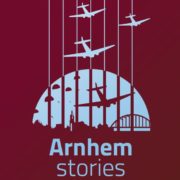 http://airbornestories.nl/
http://airbornestories.nl/